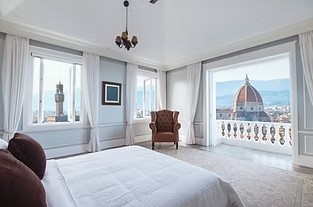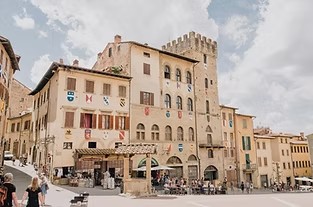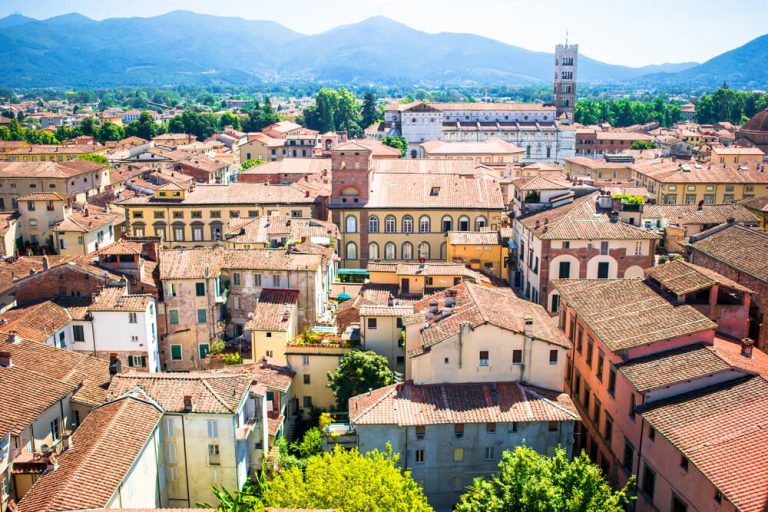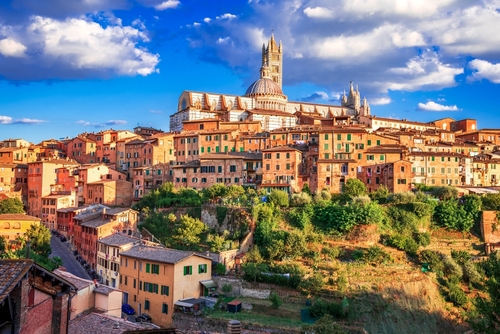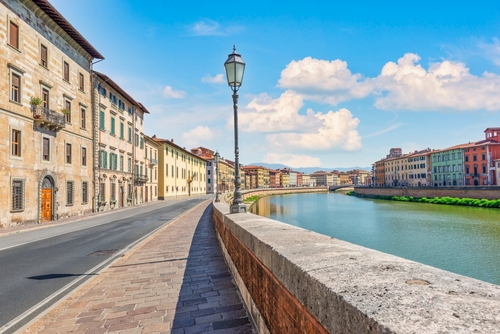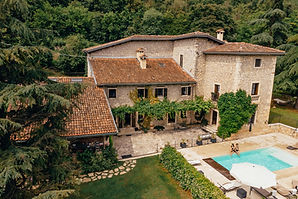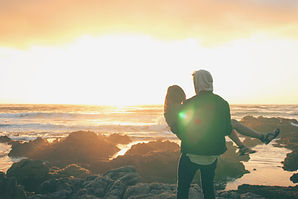Sicily
Travel Guide
Everything you need to know
Where is Sicily
Sicily is Italy’s largest island, perched on the toe of Italy’s boot in the Mediterranean sea. Its capital city, Palermo, is in the north western corner and the island’s second city, Catania, can be found on its eastern edge. Sicily is separated from mainland Italy by the Strait of Messina which is just two miles long. The island is divided into nine unique provinces – Agrigento, Caltanissetta, Catania, Enna, Messina, Palermo, Ragusa, Siracusa and Trapani.
Sicily is an island of many riches. Sun-drenched beaches give way to dramatic volcanic landscapes, punctuated with some of the most impressive historical sites in Europe. Sicily’s towns boast Baroque churches, bustling piazzas and vibrant markets to explore. The island is home to a staggering seven UNESCO World Heritage Sites. These include the Archaeological Area of Agrigento, the Villa Romana del Casale (Piazza Armerina) as well as Syracuse and the Rocky Necropolis of Pantalica. Also included are the Baroque Towns of the Val di Noto as well as Mount Etna and the Aeolian Islands. Finally seventh on the list is the Arab-Norman Palermo and the Cathedral Churches of Cefalù and Monreale. A holiday in Sicily can be many different things. However, in a land where history, culture and natural beauty meet, we can guarantee that a villa holiday in Sicily has something for everyone.
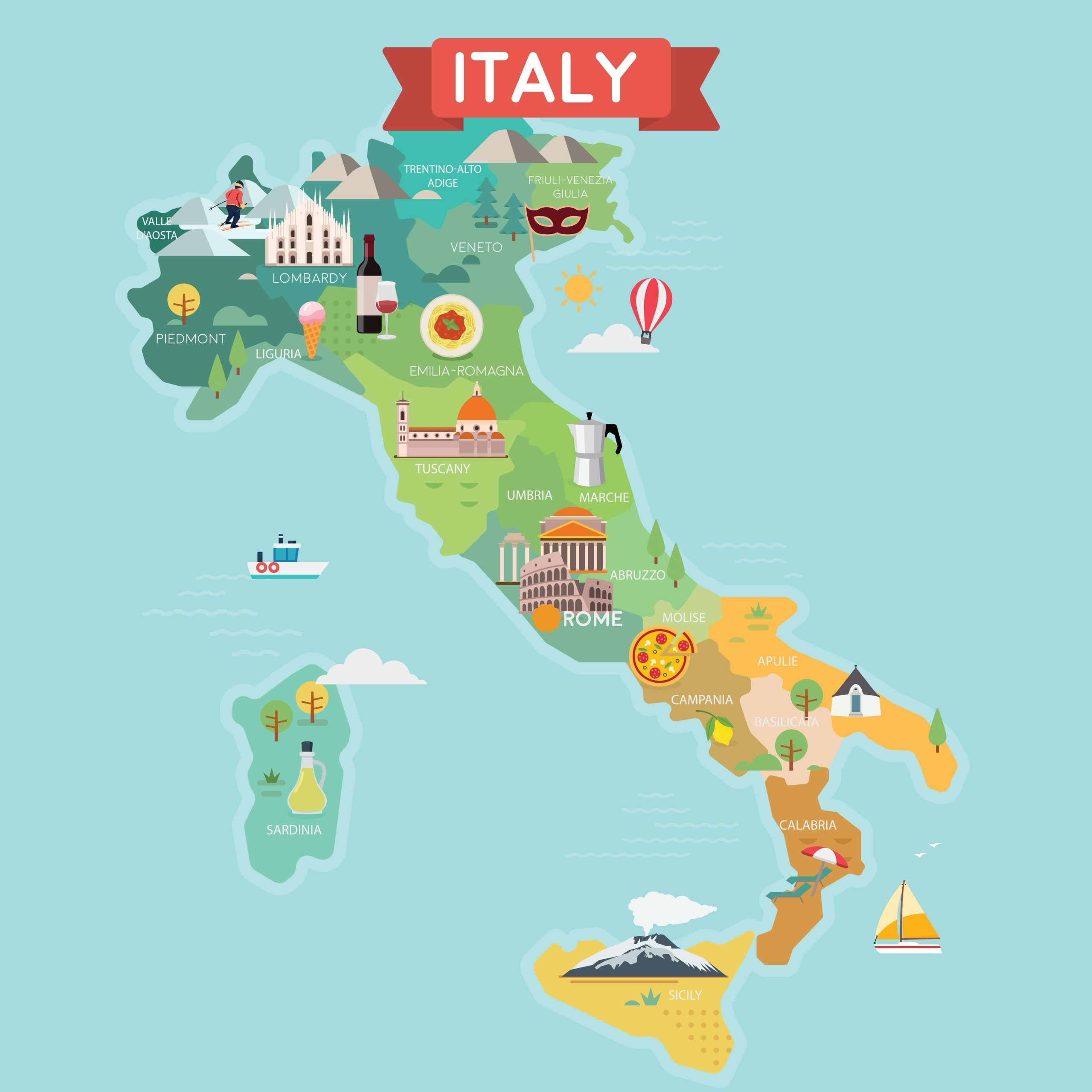
How to get there
Sicily is very easy to reach using public transport. In fact, there are probably more ways to reach it than you may think.
By Plane
Sicily is served by four international airports: Palermo (PMO), Catania (CTA), Trapani (TPS) and the smaller Comiso (CIY). The majority of air traffic either comes into Palermo in the north west or into Catania on the eastern coast.
Delta and United Airlines offer direct flights from the USA to both Palermo and Catania. There is an increased frequency of flights in the summer months but this is now a year round service. Both Lufthansa and ITA Airways also run a transatlantic service to Sicily.
From Europe, all the main carriers, including low-cost options such as Easyjet and Whizzair, offer multiple routes from most city hubs to Palermo and Catania. Ryanair operates a regular service into Trapani from London, Milan, Rome and Bologna. Sicily’s fourth and smallest airport (Comiso) is connected with direct flights to Paris, Lille, Barcelona, Prague and Tirana as well as domestic flights to mainland Italy.
By Train
Italy is one of the most rail-friendly countries in the world. Train travel in Italy can be remarkably civilised. First class offers a level of luxury far beyond that offered in the UK. Even standard class trains are clean and efficient along with being very reasonably priced.
Although Sicily is an island, you get the train to Sicily. In fact, this is one of the only routes in the world where trains are shunted onto ferries in order to cross the short stretch of water which separates Sicily from mainland Italy.
If your journey is beginning in one of Italy’s major cities – Milan, Naples or Rome – then travelling by train to Sicily is a wonderful way to see much of Italy’s magnificent coast and countryside as well as being the most environmentally friendly travel option.
Journey Times:
Milan – Palermo: 20 – 21 hours
Naples – Palermo: 9 – 10 hours
Rome – Palermo: 11 – 12 hours
For details on train times, travel options and prices visited the Trenitalia website. Or, find out all train times, prices and book tickets at Trainline. Or, for a comprehensive guide to train travel in Italy click here.
By Car
Driving to Sicily will always also involve a ferry journey from the mainland. Most visitors who opt to drive to Sicily do so as part of a scenic road trip and we would certainly recommend this for time-rich travellers.
To reach Sicily from Northern Italy, you can take the A1 motorway to Naples. From here, you could then take the A3 and then drive the final stretch on the A2 to Villa San Giovanni and Reggio Calabria. Or you could opt to take the A14 to Taranto and head down the eastern side of Italy for a while instead. All these ‘A’ roads make up the E45 motorway, a road you can in fact follow all the way from Norway!
Villa San Giovanni and Reggio Calabria is where you will find the shortest and most frequent crossing to Messina in Sicily. Crossings take just 20 – 30 minutes. However, if you would prefer to spend less time driving, there are longer ferry crossings from cities such as Naples, Genoa and Salerno. You can even catch a ferry from Civitavecchia (Rome) to Palermo. Find timetables and book tickets at Ferryscanner.
Journey times to Sicily by car:
Milan – Palermo: 15 – 16 hours
Florence – Palermo: 12 – 14 hours
Rome – Palermo: 10 – 12 hours
By Boat
As Italy’s largest island, it is probably no surprise that there are various options to travel to Sicily by boat. Villa San Giovanni and Reggio Calabria is where you will find the shortest and most frequent crossing to Messina in Sicily. Crossings take just 20 – 30 minutes. However, there are longer ferry crossings from cities such as Naples, Genoa and Salerno. You can even catch a ferry from Civitavecchia (Rome) to Palermo.
Ferries also run from Sardinia and there are international crossings from Tunis (Tunisia) to Palermo as well as from Valletta (Malta) to Pozzallo on Sicily’s southern coast.
Boat crossings from mainland Italy to Sicily:
Genoa to Palermo
Livorno to Palermo
Civitavecchia (Rome) to Palermo
Salerno to Catania, Messino and Palermo
Naples to Palermo, Catania and Termini Imerese
Reggio Calabria and Villa San Giovanni to Messina
On all of these routes, it’s possible to travel with your car or as a foot passenger. The latter is the cheaper option and you can always pick up a rental car once you’re on the island. If you are travelling in a rental car from mainland Italy, you must always tell the rental company that you intend to take the vehicle to Sicily. This can often involve a different insurance and can incur an additional charge.
Find timetables and book tickets at Ferryscanner.
By Bus
Flixbus has routes from a number of major cities in Italy to Palermo. However, these can be quite lengthy journeys and involve a ferry crossing to Messina before a final overland trip across the island to the capital.

How to get around Sicily
Once you have arrived in Sicily, you have a few options about how to get about during your holiday. We do usually recommend hiring a car – even if you don’t use it every day, it will give you so much more freedom and allow you to explore parts of Sicily that may be hard to reach using public transport. However, it’s good to understand all the options open to you.
Public Transport
Sicily’s trains link the major cities of Agrigento, Messina and Catania to Palermo and there is a further link between Catania and Syracuse. However, that’s where it ends. These routes can feel quite limiting, especially if you plan to discover the Island’s UNESCO World Heritage Sites or head even slightly off the beaten track. Moreover, trains in Sicily are slow in comparison to the high-speed lines of the mainland. The journey from Palermo to Catania can take more than 3 hours. Services can also be unreliable and timetables often change during a festival or public holiday.
That said, if arriving at Palermo airport and looking to head to the city centre, there is an efficient train service to take you into the heart of the city. The journey time on the Trinacria Express takes approximately 45 minutes and trains leave every half an hour. There is no rail link between the airport in Catania and the city centre.
We recommend you use the Trainline app for all ticket purchases and to plan your journey, not least because many of Sicily’s smaller stations no longer have a working ticket office.
Buses in Sicily tend to be a better option than the trains, and give you access to almost the whole island. Even some of the smaller, more remote villages often have a bus service of some sort. However, timetables can be loosely followed and much like with the train service, be aware of significant changes (or no service at all) on public holidays or during festivals and feast days.
There is no national bus network in Italy. Most buses are regional. And, even within the same region, there can often be multiple companies operating. In Sicily, the main bus routes are operated by AST, Interbus, SAIS, and Etna Trasporti – with the bus stations at Piazza Cairoli (Palermo) and Via Archimede (Catania) acting as main hubs.
Tickets are usually bought online, however some newsagents near main bus stops still sell paper tickets. Each bus company has their own website and these are a good place to start. However using a site such as Omio will allow you to compare routes and prices on offer from all the companies operating on a certain route.
In addition, Catania has a small urban metro line which connects the city’s port to its more suburban areas. Since most visitors to Catania don’t arrive into the port, it’s not usually used by tourists. And while it is an option when travelling around the city centre, more often than not, it’s much more efficient to walk if you’re just going one or two stops.
Renting a car and driving
There are a number of benefits to driving a car in Sicily. Not least, it allows you to explore Sicily at your own pace. But it also enables you to discover Sicily’s charming hilltop towns, hidden beaches and more remote archaeological sites. All of Sicily’s major airports are well served by both international and local car rental companies so hiring a car is very straightforward. Bookings For You recommend AutoEurope for all your Italy car hire needs. But comparison websites such as Skyscanner and Trip.com are also a good place to start your search.
There are four types of roads in Sicily: motorways (autostrada), state roads (superstrada), regional roads (strade regionali) and provincial roads (strade provinciali).
The A19 connects Sicily’s principal cities – Palermo and Catania – cutting through the centre of the island. Catania is also linked to Messina by the A18 and Palermo to Messina by the A20. Although it is not a motorway, the SS115 is a good main road which roughly follows the island’s southern coast, linking the towns of Agrigento, Sciacca and Marsarla.
While these main roads are the most efficient way to travel between Sicily’s major towns and cities, we do recommend heading off the beaten track at least a little. Sicily’s regional roads can take you through some absolutely stunning landscapes and you can stumble across some magical hidden gems. Sicily’s interior is mountainous and magnificent in equal measure and there is some real authentic Sicily to discover if you have the time for a little slow travel.
Although we do always recommend that our guests hire a car in Sicily, we do also have to be honest about the practicalities of driving a car on the island. It’s probably fair to describe the majority of Sicily’s native drivers as assertive! In our experience as a visitor, it’s best to either go with the flow or move out of the way – pronto!
Finally, whilst we recommend using local roads, be aware that road markings can sometimes be sparse and the road surface may also be in need of repair. In towns and cities, be prepared to squeeze through tiny alleys and to share your space with scooters – sometimes on all sides of your car.
Drivers in Sicily should also be aware of Zona Traffico Limitato (ZTL). These restricted traffic areas prohibit non-resident vehicles from entering. Cefalu, Marsala, Sciacca, Ortigia and Syracuse, Trapani, Palermo and Agrigento are amongst the towns and cities in Sicily which have a ZTL in operation.
The principle behind ZTLs was to reduce pollution and limit damage to streets and buildings in historic centres. However, a byproduct is that they have created a much nicer experience for those exploring these areas on foot. The ZTLs are usually active during certain specific hours so you must read the signage carefully.
Entrances to a ZTL are clearly signed, indicating that you are entering a restricted traffic area. The signs consist of a white circle with a red border on a white background. The words Zona a Traffico Limitato are always written above the circle. Below there will be information regarding the timing that the restrictions are in place. For example, a sign stating 8.00 – 20.00 would indicate that the restrictions are in place between 8am and 8pm. Your rental car will not have a permit to access these areas. Nor will your own vehicle. The only exception will be if you have booked accommodation within a ZTL and your Sicily villa or hotel provider has already informed you that you are able to enter the area and have already taken a note of your car registration plate. If in doubt, check with them before entering.
Entrances to the ZTL are marked by security cameras. These will immediately record your registration number if you enter and a fine will be issued should you be breaking the restrictions. In fact, you can be fined multiple times – each time you pass a security camera, you can get a new fine. Fines can be up to €300, so it’s a costly mistake to make! Don’t assume it’s OK to enter if you happen to see other vehicles inside the area. Residents are normally allowed to enter as is public transport. And don’t be fooled by what your GPS or SatNav system might be telling you to do – even if it’s set to avoid tolls. They don’t always inform you that you’re entering a restricted traffic zone.
By Bike
Exploring Sicily by bike is becoming more and more popular. This could be because we are becoming increasingly conscious of the environment but we think it’s mostly due to the rise in popularity and availability of electric bikes.
Sicily’s landscape is typically hilly so relying on pedal-power alone can be quite strenuous – especially in the heat of high summer. There are several scenic cycle routes on the island. One of the most challenging – but equally rewarding routes is the EuroVelo 7 Sun Route. This takes cyclists through the mountainous heart of the island – from Trapani to Catania. Unless you are an experienced cyclist, we recommend joining a guide for this ride. There are many companies who offer guides and tours by bike in Sicily and it’s also possible to hire bikes and e-bikes. Click here to see what’s on offer.
Palermo
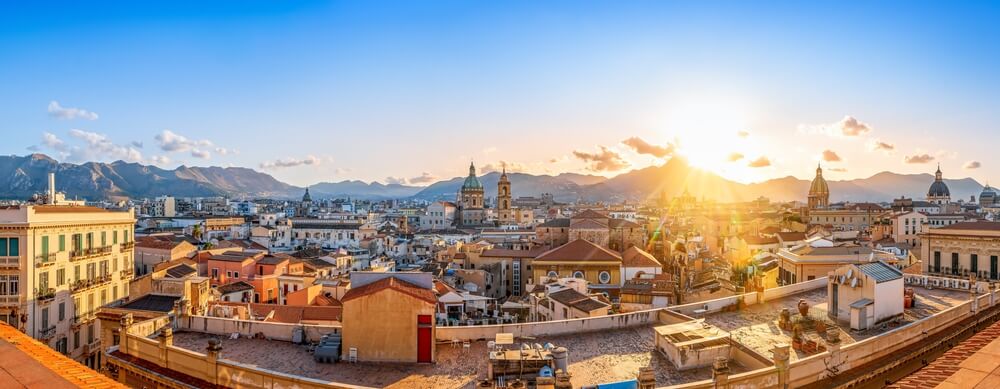
Introduction to Palermo
Palermo is the vibrant capital of Sicily. A city with an incredibly rich and diverse history, it is often described as a crossroads of civilisations. Over the years it has been influenced by the Greeks, Arabs and Romans and all have left their mark. Palermo is a must-visit city on any Sicily itinerary and can make a great starting point to a longer holiday on the island. Its international airport has fast and frequent rail links directly into the city centre. So it’s also a perfect stand alone city break.
The city is divided into three main areas: Centro Storico, Mondella and Politeama and Via Libertà. The Centro Storico is actually a combination of four smaller neighbourhoods: Kalsa, Albergheria, Castellammare and Il Capo. Together these create the historic old town of Palermo. This is where you will find the must see attractions in the city. If you’re short on time when visiting Palermo, we recommend spending pretty much all of it here. The ancient alleyways are full of stories of the island’s turbulent history and the piazzas ooze authentic Sicilian life.
By contrast, Politeama and Via Libertà offer a chic, more contemporary take on the city. Here visitors will find high end shops and restaurants offering fine dining. If you have a few days in Palermo this area is definitely worth a visit for a coffee and some people watching. Finally, Mondella. Although technically just outside of the city, this is Palermo’s beach neighbourhood and it is well stocked with seafood restaurants and lively bars full of locals enjoying a few hours or days at the beach.
Top of most visitor’s to-do lists is the iconic Palermo Duomo. A blend of Norman, Moorish, Gothic and Baroque styles, with magnificent rooftop views across the city, it never disappoints. Trips to the markets at Ballarò and Vucciria are also recommended. Arrive hungry and you’ll leave full of delicious Sicilian treats. Opera fans must also head to the Teatro Massimo – Italy’s largest opera house. Discover our full guide to the best things to do in Palermo.
Tips for navigating the city
Palermo airport is just 24km from the city centre. Direct trains connect the airport to the city’s main rail station with typical journey times at around 50 minutes. Tickets can be bought at the airport or online on the Trenitalia website. A one way ticket costs €6.
Despite being Sicily’s capital city, Palermo is very easy to get around. The old town and much of the centre can be explored very easily on foot. This is always our optimum way to discover any Italian city. There are buses which operate in the city and surrounding neighbourhoods too. The trip to Mondello is usually taken on the number 806 and takes about 30 minutes. Buses in Sicily are generally good value, with this trip costing about €1.50. An alternative is a taxi which will set you back about €30 each way. Either way in the summer, be prepared to sit in traffic during this journey.
Bike hire is also possible in Palermo. Several local shops offer very reasonably priced cycle rental. Another option is to join a tour with a local guide. Click here to see what’s on offer.
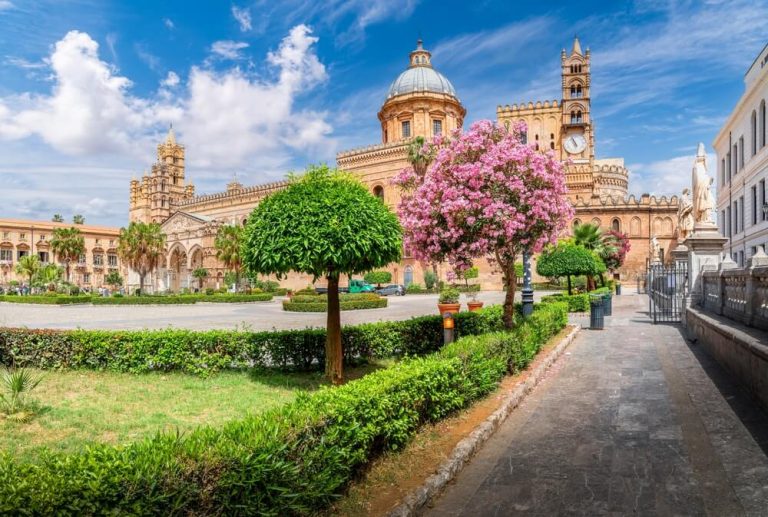
Accommodation and dining recommendations
If you plan to stay overnight in Palermo, there are plenty of accommodation options on offer, suitable for all budgets. These include hotels in Bari, B&Bs as well as a good selection of apartments too. Just be aware that, whatever option you choose, you will need to pay a tourist tax. In Palermo, like everywhere in Italy, the tourist tax applies to all accommodation but the amount due depends on the type and rating of your hotel or holiday rental. Typically costs are between €1.50 and €4 per person per night. The tax applies to all visitors aged 14 and over and it is applied for a maximum of four consecutive nights.
Alternatively, given how easy it is to reach Palermo by public transport, you could also opt to stay in a Sicily villa in the beautiful Sicilian countryside. Villa Palermo is an excellent option. At just 30 kms from the city it’s the perfect place to use as a base to explore the area.
However, we do recommend spending a night in Palermo if you can. The city comes alive at night with bars and restaurants bustling with tourists and locals alike.
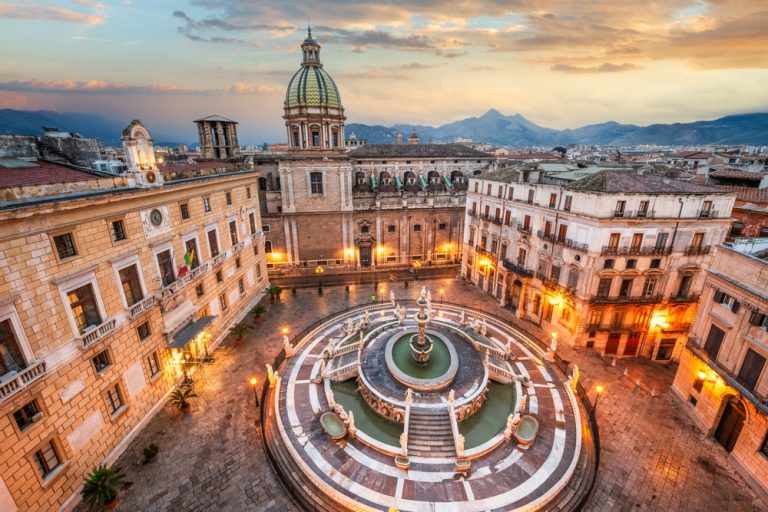
Palermo is a mecca for foodies. As Sicily’s capital and with a rich fusion of cultures, food in Palermo is central to almost everything. Street food takes centre stage with the city’s food markets offering relaxed dining and the chance to try a variety of local specialities. Sardines are a favourite, often served with spaghetti or in a roulade with raisins and pine nuts. We also recommend trying sfincione. This is Palermo’s most famous street food and their take on the classic Italian pizza. Expect a thicker base, almost like a focaccia. These are most often topped with cheese, rich tomato sauce and anchovies.
If you’re looking for a finer dining experience, Palermo has some excellent options too. One of the best is MEC – home of Michelin starred chef Carmelo Trentacosti. Find out more in the Michelin guide to Palermo’s top restaurants.
Sicily’s wine is delicious. Sturdy reds stand along crisp whites and are some of the finest Italian wines. The island’s year-round mild climate makes for excellent growing conditions. Ask a waiter for a recommendation or for the family wine. Often not even on the menu and served in jugs or carafes this is how to taste truly authentic Sicilian wine.
Evenings begin with aperitivo – often spritz and finish with digestivo. The most traditional of which is amaro averna. This is a bitter-sweet herbal liqueur and we have decided that it must be an acquired taste! However, more often a meal can finish with a delicious (often home made) limoncello.
Catania
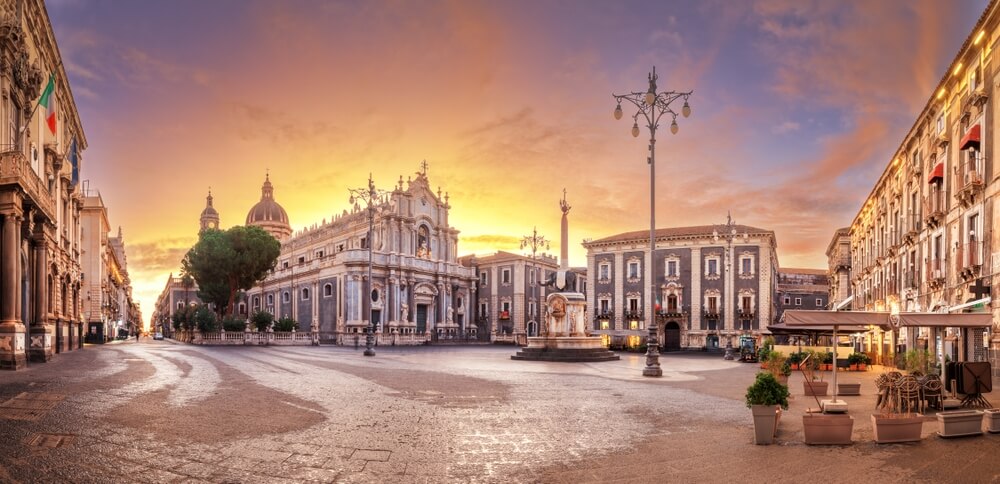
Introduction to Catania
Sicily’s second city, many visitors to the island find Catania as the starting point of their trip. Catania is a thriving working city which is dominated by the gently smouldering Mount Etna in the background. Perched on the south eastern coast, Catania’s landscape has been shaped by century-old earthquakes and volcanic eruptions. The architecture is largely Baroque as much of the city’s more ancient buildings were destroyed in an earthquake in the 1600s.
Spend your time in the Centro Storico where you will find the Piazza del Duomo and Via Crociferi. Here you can discover Catania’s finest Baroque churches and stunning architecture. It’s also home to La Pescheria – Catania’s biggest fish market. However, this is more than just a place to buy your supper. La Pescheria is the heart and soul of the city, buzzing with locals haggling and hanging out. A true taste of authentic Sicily. This area is also home to Teatro Romana and the ruins of the Odeon. Muddled in amongst more modern architecture, this defines Catania’s adaptation over time.
Tips for navigating the city
The airport is just 7 kilometres from the centre of Catania and is served by a regular bus service (often called the ‘Alibus’) operated by AMTS. The journey takes about 30 minutes and costs just €4.
The centre of Catania is relatively easy to explore on foot. Most attractions are in the centre and fall within about a 15-20 minute walking radius. However, if you want to head to the beach areas or beyond, the city is served by a good bus service operated by AMTS. There is also a small metro but this is not always very useful to tourists as it mostly links the port and train station to suburban areas.
Cycling is another option in Catania. However, we should warn you that Catania is quite hilly and the roads can be busy with some rather assertive drivers! We recently discovered e-bike rental in Catania which at least takes care of the hills. This is also a great option if you want to head out of the city to the coast.
If you plan to visit Catania for the day from your Sicily villa rental then we recommend using the train. In many cases this means driving from your Sicily villa to a nearby station, where you can often park free of charge. You can then journey into the city car-free.
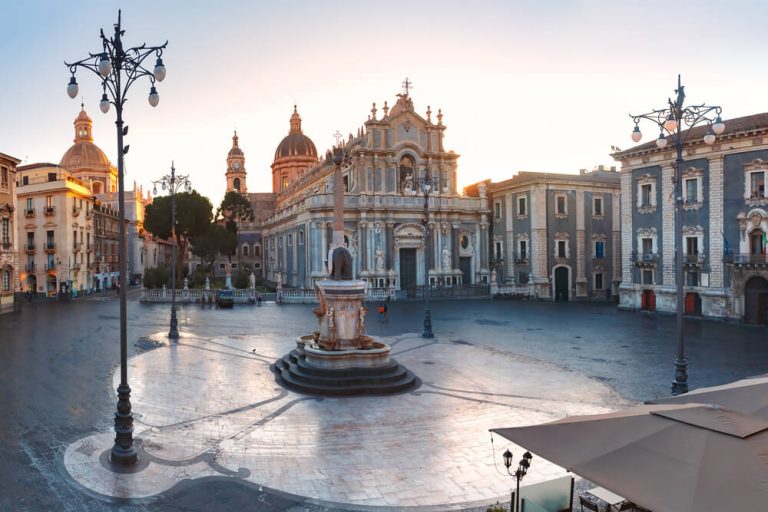
Accommodation and dining recommendations
Spending a night in Catania is often a great add-on to the beginning or end of your Sicily villa holiday. Especially if you are flying in or out of the airport in Catania. There are plenty of accommodation options on offer in the city centre, suitable for all budgets. These include hotels in Catania, family run B&Bs as well as a good selection of self-catering apartments too. Do be aware that, whatever you choose, you will need to pay a tourist tax. In Catania, like everywhere in Italy, the tourist tax applies to all accommodation. However, the amount due depends on the type and rating of your hotel or holiday rental. Typically costs are between €1.50 and €4 per person per night. The tax applies to all visitors aged 14 and over and it is applied for a maximum of four consecutive nights.
Fish and seafood dominate menus in Catania. There are several big fish markets and the city’s love of all things fishy is felt in so many of their dishes. A top tip is to visit one of the tiny trattorias on the edges of the markets. Here you’ll find sensational seafood at real bargain prices.
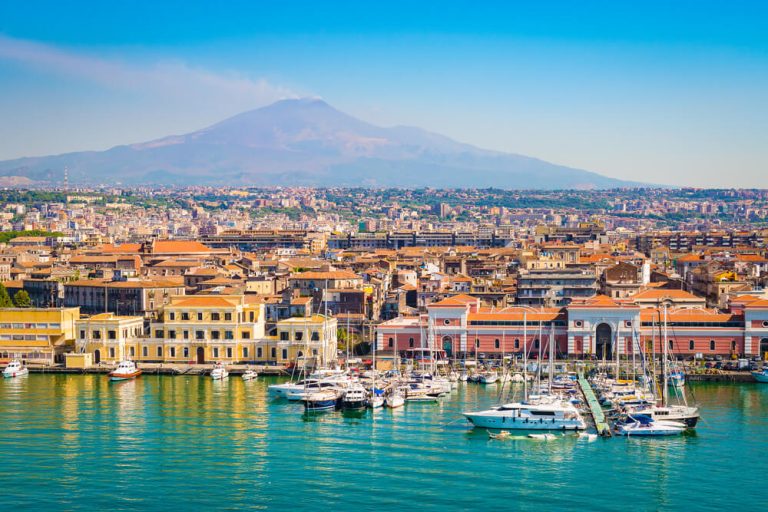
A true local speciality is pesce spada alla ghiotta – swordfish cooked with tomatoes, olives and capers. However, Catania is also a good stop for vegetarians. Unlike Palermo, there isn’t much meat on the menu and the Catania classic – Pasta al Norma (pasta with tomato sauce, fried aubergine, basil, and ricotta) – is a delicious meat-free option. You must also try Catania’s take on the classic Sicilian arancini. Often cone-shaped to represent Mount Etna, the fillings are unimaginably creative.
Catania also has superb, more formal dining options too. The Michelin guide includes some of the best fine dining restaurants in Catania. Wherever you eat, we recommend you finish your meal with a liqueur. In Catania this is more often made from pistachios.
Agrigento
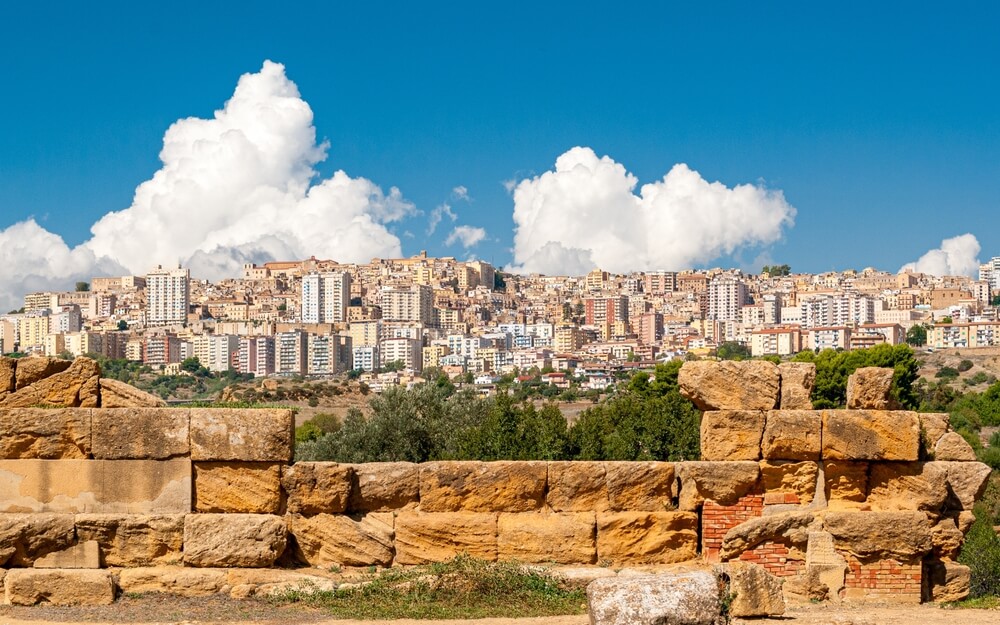
Introduction to Agrigento
Perched on the dramatic southern coast of the island, Agrigento is a bustling city where the marks of ancient civilisations live alongside modern Sicilian life. At its heart (although slightly out of town), is The Valley of the Temples. As one of the most recognisable UNESCO World Heritage sites in the world, this majestic archaeological site dominates the vista above the city. The temples are easily seen as you make your approach into the city and at night they are tastefully illuminated so they can be seen for miles. Standing among the columns of the Temple of Concordia or the dramatic ruins of the Temple of Zeus, you can almost feel the weight of 2,500 years of history embedded in the land. Yet Agrigento is not merely a relic of the past. Its bustling historic centre is filled with narrow lanes, sunlit piazzas, and vibrant Sicilian life.
While many visitors use Agrigento as a base to explore the numerous nearby archaeological sites, the city itself has a lot to offer. Visitors are naturally drawn to the Centro Storico whose highlight is a visit to the Cathedral of San Gerlando. And while Agrigento is home to more churches than we could ever list, there is one that stands out to us. The church of Santa Maria dei Greci is a Catholic church which was built on the remains of a 5th century Doric temple. On making this discovery, archaeologists began the painstaking excavation of the site and have since installed glass panels into the church’s floor so you can see into the temple below.
Beyond the historic centre, Agrigento boasts some stunning sandy beaches and there are plenty of beach hotels to choose from in the San Leone district or heading south towards Cannatello. Equally, the hills which surround the city offer majestic views of the Temples and and the surrounding countryside. In more recent years several luxury resorts have been established just west of the centre and in the immediate vicinity of the Valley of the Temples. These are often open to non-residents too, and offer some superb dining options with the most majestic views of the temples at night.
Tips for navigating the city
The city’s nearest airport is in Palermo, which is about 65 miles away. Another option is to fly into Catania airport but this is 100 miles from Agrigento. While neither are easily reached by public transport, Palermo is the better option. After a 30 minute transfer from the airport to the central station the trip to Agrigento takes just over 2 hours. If you’re arriving into Catania, we recommend renting a car. The journey by train involves at least 2 changes and can take over 7 hours!
Agrigento is not a huge city and is largely accessible on foot. However, its wonderful vantage point does mean that there are some fairly steep hills to negotiate. To help visitors who may find this a challenge, the city is well served with rickshaws and taxis. However our best advice is to take your time and enjoy strolling up the hills and climbing the steps, making sure you leave plenty of time for a stop in a cafe or gelateria to re-charge!
A trip from the centre of the city to the Valley of the Temples takes about 10 minutes by car and there is plenty of reasonably priced parking nearby. The number one bus also makes this journey and runs every 30 minutes from Piazzale Roselli, just outside the main railway station. Tickets can be bought in advance from kiosks, but remember that you must validate your ticket once on board. This website has all the information you need about bus travel in Agrigento, including timetables and routes for the different lines.
We recommend allowing about 4 hours for this excursion. Remember to wear comfortable walking shoes. While there are marked paths between the temples, these can be quite uneven and you will easily rack up your daily step-count as you stroll around the park. There is a cafe for drinks and snacks and also a good restaurant for a more substantial meal. To get the most out of the experience, we recommend joining a group tour or even better hiring a private guide. In our experience, the guides at Sicily’s UNSECO world heritage sites are incredibly knowledgeable archaeologists and they are masters of creating entertaining and engaging tours. If you get the chance, try visiting as night falls. Not only is the sunset exquisite, but after dark the temples are illuminated and perhaps look even more spectacular.
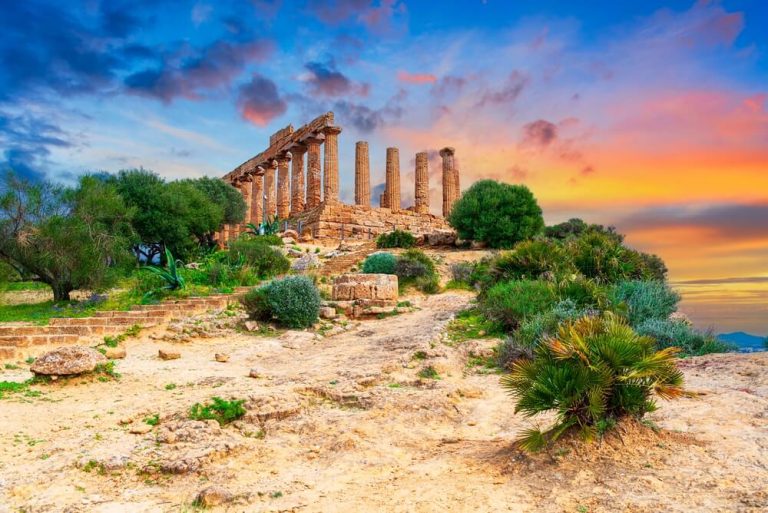
Accommodation and dining recommendations
Agrigento has a good stock of hotels and B&Bs in the centre along with plenty of self catering apartments. There is definitely something for every budget. Also consider the beach hotels which can offer excellent value especially if you’re travelling in the summer or autumn months. If you opt for a Sicily villa rental, then the journey into Agrigento is easily made.
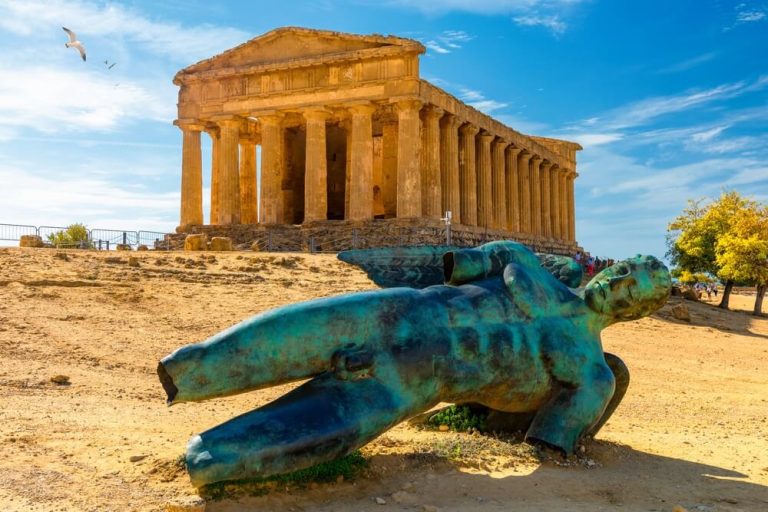
Food in Agrigento is typically Sicilian. There’s plenty of fish, and anchovies feature in many of the city’s signature dishes. Again, expect stuffed sardines and arancini filled with all kinds of delights. One of Agrigento’s specialities is caponata Agrigentina, a dish made of fried aubergine, celery, onions, tomatoes, capers, and olives. Agrigento’s version is especially rich, sometimes including peppers, almonds or pine nuts.
Informal street food is ever popular in Agrigento and it’s a great way to be able to sample lots of different local specialities. However if you fancy something more formal heading out of the city, in and around the archaeological park there are some impressive restaurants. A real gem is the restaurant at the Villa Athena Resort. This is actually within the archaeological park and has magnificent views of the temples along with some exquisite local cuisine.
Cefalù
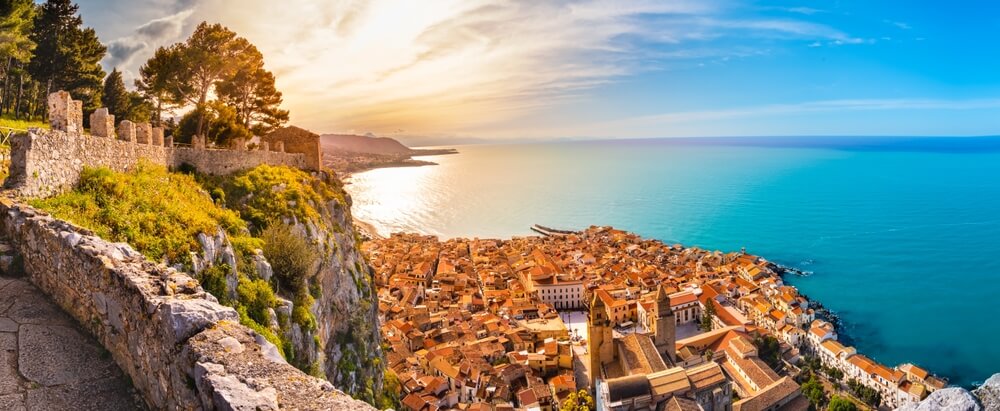
Introduction to Cefalù
Cefalù is situated on the north west coast of Sicily, about an hour to the east of Palermo, an hour west of Capo d’Orlando and about 200 km north west of Catania. The origins of the town go as far back as the ancient Greeks. However, what you see today dates from the period of the Normans onwards. Cefalù is a mix of architectural styles reflecting its rich history. As well as Norman influences, you’ll also discover Byzantine, Arab and Spanish styles during your visit. It’s definitely a ‘must see’ when staying in one of our Sicily villa rentals, many of which are situated nearby.
Situated at the foot of the dramatic La Rocca cliff and flanked by the turquoise waters of the Tyrrhenian Sea, Cefalù offers visitors the perfect balance of culture and relaxation. The town is famed for its Duomo – a UNESCO World Heritage Site, its sandy beaches, and winding medieval streets filled with artisan shops and trattorias
Tips for navigating the city
The nearest airport to Cefalù is Palermo. By train, the journey takes about 90 minutes with a change at the central station in Palermo. However, probably the easiest option is to rent a car. The A20 motorway links the airport to Cefalù, with the journey time about an hour and 20 minutes. An alternative is Catania airport, however we don’t recommend taking the train from here as it can take up to 4 hours. Rent a car and the journey time is almost halved.
Cefalù is a compact city. All of the attractions in the city centre are easily accessible on foot. The ancient lanes and alleys are often cobbled or unevenly paved so we do recommend wearing comfortable footwear. More adventurous travellers will enjoy the hike up Rocca di Cefalù. This is the iconic cliff that towers above the city. Allow about 2 hours for the up and down hike and we recommend starting early to beat the heat. The park opens at 8am and the last entrance of the day is 6.30pm. Entry costs €5 per person.
Bike and scooter rental is another option to explore the city and surrounding coastal areas. The centre and beach areas are relatively flat, however if you plan to venture further afield be prepared to tackle some significant inclines. If you’re arriving by car, remember that the centre of Cefalù has several ZTLs so it’s usually best to park just outside the centre.
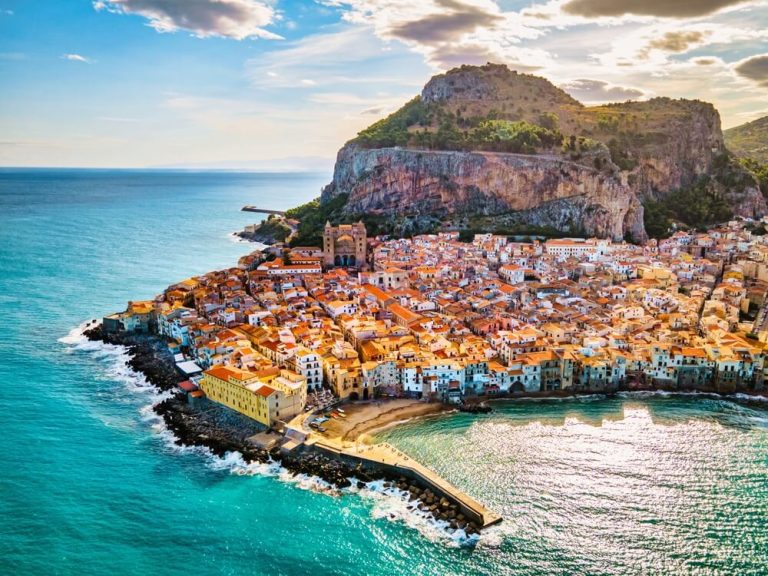
Accommodation and dining recommendations
While you can of course stay in Cefalù, this city is easily explored in a day so often opting for a Sicily villa or apartment is a better option. Nestled in the Parco Delle Madonie nature reserve and boasting stunning sea views, Casa Terre di Bea is a perfect choice. The property is situated just 5 kilometres from Cefalù. It’s also just a 5 minute drive from the villa to the most spectacular beaches along this stretch of the Sicilian coastline and only 1.5 km from the beautiful fishing village of Sant Ambrogio.
If you do choose to spend a night in the city itself, there are several boutique hotels in the historic centre along with larger beach hotels on the outskirts of the city.
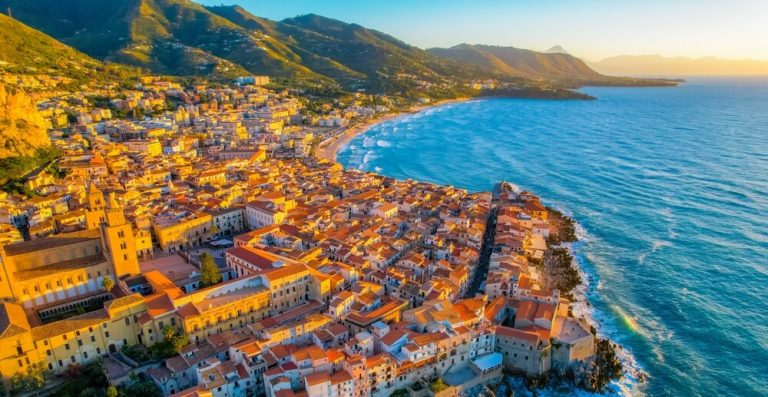
Swordfish, anchovies, calamari and sardines are all menu staples. Locals enjoy these grilled al fresco but also in pasta and risotto. The Piazza del Duomo is packed with cafes and restaurants and although these are tourist hotspots, they also make for some of the best places to enjoy a coffee and cannoli and get in some superb people watching. Head into the city’s ancient alleys to find smaller local restaurants with fewer tourists.
To stock up on the freshest local ingredients to cook up a feast in your Sicily villa, head to Cefalù on a Saturday morning to enjoy the lively weekly market. Arrive early and hungry.
Syracuse
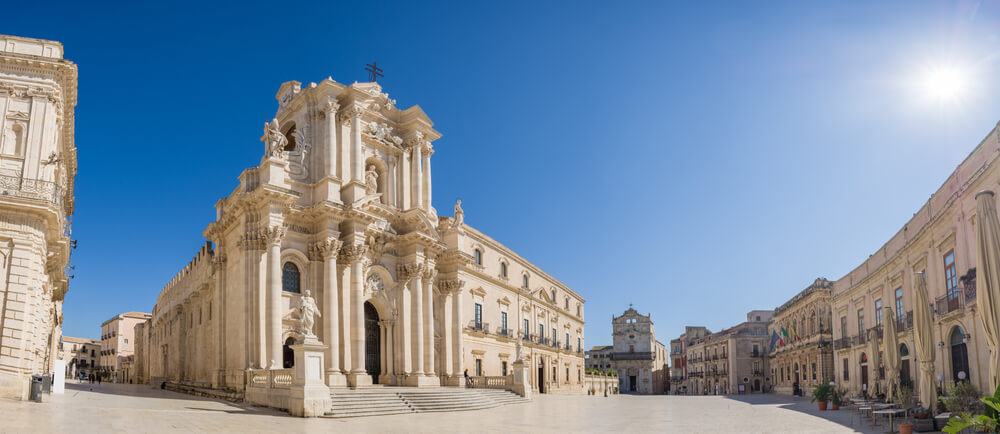
Introduction to Syracuse
Located on Sicily’s south east coast, Syracuse was once the most powerful city of Magna Graecia. It rivalled Athens in both size and influence. Today, its streets, piazzas and coastline offer travellers a wonderful combination of archaeology, architecture and authentic Sicilian life. It’s a small city, but one that has a lot to offer. The two main attractions are the island of Ortiga and the archaeological park of Neapolis.
Ortiga is connected to the mainland by three bridges and is largely car-free due to the entire island being a ZTL. A highlight in Ortiga is the food market. This is open every morning (except Sundays) and almost looks like the contents of a Sicilian cook book have been piled upon pallets or displayed in buckets and bins. It’s truly authentic Sicily and also a perfect place to drop into one of the attached cafes or restaurants for some lunch.
The Piazza Duomo is at the heart of Ortiga. The cathedral is imposing and impressive in equal measure and well worth a visit. This square is also home to a smaller, more intimate church – the Chiesa di Santa Lucia alla Badia. Whilst smaller, it is well visited thanks to being home to one of Caravaggio’s last works, the Burial of Saint Lucy.
Back on the mainland, the main attraction is the archaeological park of Neapolis. This is a beautiful park with plenty of natural shade from the canopy of trees which line the well marked paths. There are also some very interesting sculptures arranged amongst the trees. The first stop for most visitors is the Greek theatre where there are regular concerts and events held throughout the summer months. It’s wonderfully well-preserved and equally impressive in size. There is also a Roman amphitheatre, which was once the venue for gladiator duals. The final attraction in the park is the Ear of Dionysius. This is a vast limestone cave with remarkable acoustics, named after the tyrant Dionysius. Investing in a guide is almost essential to get the most out of your visit. As historians and archaeologists, their knowledge is unrivalled and their presentation wonderfully engaging. Click here to book your tour.
Tips for navigating the city
Syracuse is small but perfectly formed! It is divided into two main areas. These are Ortigia and the mainland city, where the archaeological park and residential areas are located. Ortiga is best explored on foot. After all, the whole island is only just over 1 kilometre wide. This makes it the perfect place for a wander and you will undoubtedly stumble across a tiny shop selling hand made jewellery or a family-run artisan bakery selling divine sweet treats.
If you are arriving by car be sure to park on the mainland as the entirety of Ortiga is a ZTL. There are plenty of car parks along the road next to the port in the south of the city and likewise next to the archaeological park. Arriving by train is a very good option too. The journey from Catania takes just over an hour. Once you’ve arrived, if you don’t fancy a long walk then there are plenty of local buses as well as tuk-tuk tours which can take you over to Ortiga. The SAIS website is the best place to look for bus times and routes.
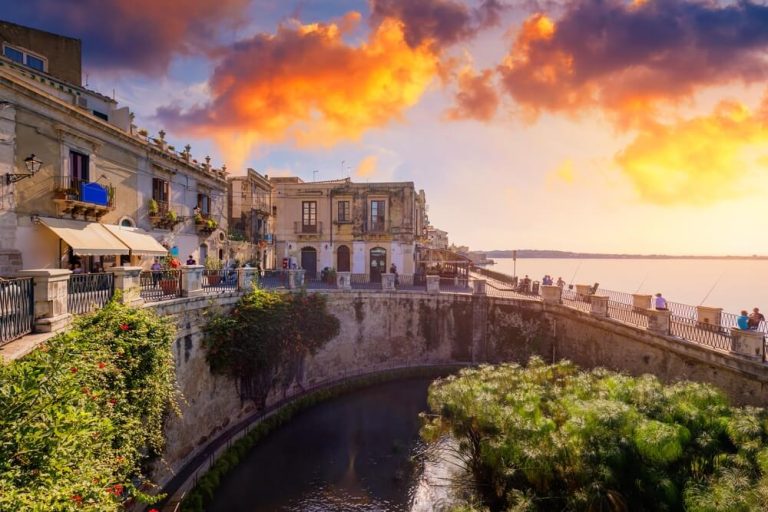
Accommodation and dining recommendations
While there are some hotel options to stay on Ortiga, it is not always the best option. The island can become crowded and the accommodation there is often expensive. We recommend either staying on the mainland, where you will get better value for money, or even better choose a Sicily villa in the island’s stunning countryside and enjoy some peace and quiet after a day in bustling Syracuse.
To get a real taste of what Syracuse has to offer we recommend heading to the food market held in Ortiga daily (except Sundays) from 7.30 – 14.30. Here you can stock up on fresh local ingredients to cook at your Sicily villa.
Like in all of Sicily, street food is king in Syracuse. Locals can often be seen tucking into cucce. Made from puff pastry filled with cheese and sausage, these are typically eaten with an aperitif or as a snack. Pasta alla Siracusa is a favourite first course. This pasta dish has a tomato and garlic base, often with aubergine added, but always with garlic and a healthy helping of anchovies. Some chefs like to add breadcrumbs too.
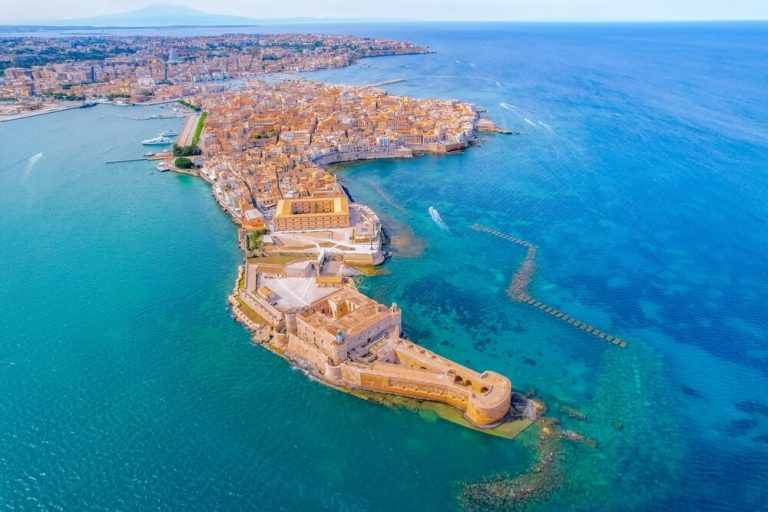
Puppeti Ri Muccu is a real Syracuse speciality. The main ingredient is fish roe. This is combined with egg and breadcrumbs and then lightly fried in bitesized balls. You won’t find them on a tourist menu but if you get the chance then try them. They’re absolutely delicious.
Syracuse has some excellent fine dining options too. However, if you’re looking for an authentic Sicilian dining experience, we recommend joining a local in their home for a cooking class. Not only will you get to learn from an expert but you will also get to enjoy the delicious fruits of your labour.
Taormina
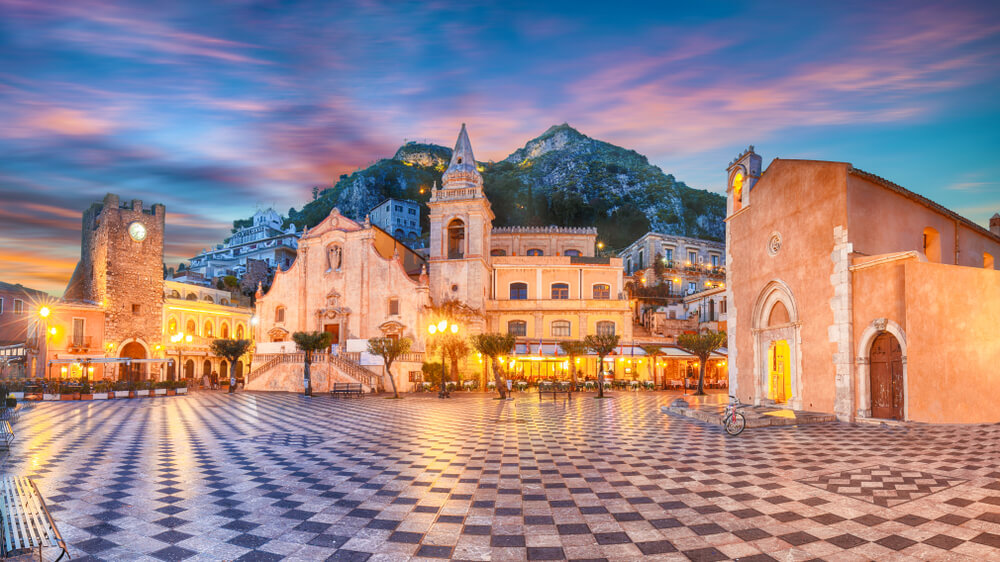
Introduction to Taormina
Perched on a hilltop overlooking the Ionian Sea with Mount Etna looming in the background, Taormina is one of Sicily’s most dazzling towns and it has been welcoming tourists for over 100 years. As far back as the 19th century, it would have been part of the ‘Grand Tour’, however its origins go back much further than that to the Iron Age when the Sicels were an Italic tribe who inhabited Eastern Italy. The Siculi were followed by the Ancient Greeks who arrived on the Sicilian coast in 734 BC.
More recently, in the late 19th and early 20th centuries, it attracted a number of prominent artists and writers, including Roald Dahl, Bertrand Russell, Tennessee Williams and DH Lawrence. These days, it is a popular tourist destination that attracts thousands of holidaymakers each year.
Arguably, Taormina has it all. Magnificent views, fascinating historical sites and some of the finest beaches in Europe. Perhaps the star attraction is the Teatro Antico (ancient theatre). Built by the Greeks in the 3rd century BC and expanded by the Romans, it’s still used today for concerts and film festivals. The backdrop of the stage frames Mount Etna and the sea. This is undoubtedly one of the most spectacular views in Italy. But there is another unmissable view in Taormina. Head to Piazza IX Aprile for a coffee in one of its bustling cafes and drink in the views from here over the coast to Mount Etna. This is a favourite spot to watch the sun set with an aperitif. Taormina is probably one of Sicily’s most instagrammable cities and this view is perhaps up there with the most likes.
However, in Taormina there’s a lot of competition for this top spot and Isola Bella is definitely a front runner too. A tiny island linked to the mainland by a strip of sand, Isola Bella is picture perfect Sicily. Once the home of Lady Florence Trevelyan, a keen botanist, she transformed the island into a paradise of exotic plants. Today it is a protected nature reserve open to the public from nine in the morning until one hour before sunset. The water here is exquisitely clear and it’s a magical spot for a swim. However, as with much of Italy in the summer, it can get quite busy, especially in August. Our advice is to arrive early with a picnic breakfast or come later in the day when the crowds have eased.
Tips for navigating the city
Taormina’s nearest airport is Catania and the quickest way to make this 65 km journey is by car. This journey takes about 1 hour and the route, although a bit windy, has some of the most spectacular views on the island. By train, head first to Catania Centrale (about 20 minutes from the airport) and then take a train to Taormina-Giardini which should take around 1 hour. The station is a little bit out of town. Whilst in theory you can walk to the centre from the station in about 30 minutes, we wouldn’t recommend it. The roads are steep and narrow and often populated by some very enthusiastic Italian drivers! There are also steps to contend with and sections where the pavement is in poor repair. In places it even disappears. Instead, buses run regularly from the station to the centre, but the easiest option is a taxi which will takes about 7 minutes and cost about €15.
We do not recommend driving in the centre of Taormina. The streets are narrow and the whole of the historic centre is a ZTL. However if you do arrive by car, we recommend parking at the Porta Catania car park. This has lifts which take you up to the old town. Alternatively the Lumbi car park which is slightly further away close to Porta Messina, offers a free shuttle bus running from 7am until 12.50am and to 1.50am on a Saturday night. There is also the smaller Porta Pasquale parking. This only holds 75 cars so is only recommended if you have arrived very early in the day or during the off-season. Mazzarò has its own parking area which is best if you are planning to visit Isola Bella or any of the beaches.
Taormina’s magic lies not only in its views and architecture but in how it unfolds across terraces and cliffside paths. Getting around is part of the experience but having a few tips will make your time in the city smoother and more enjoyable.
The old town is set about 200 metres above sea level on the slopes of Mount Tauro. The centre is compact and easily explored on foot. Most of the main attractions are centred around Corso Umberto. This is the main street in the city centre which stretches between Porta Messina and Porta Catania, the upper and lower city gates. This is a wide pedestrianised street lined with shops and casual bars and restaurants. From this focal point, there are many side streets and steps which lead to hidden piazzas and a maze of ancient alleys. These can be a welcome break from the main drag which can become crowded with visitors in the summer months. They will also often lead to yet another stunning view down to the sparkling azure water below.
The remainder of the city and its stunning beaches can be discovered tucked below the old town at sea level. This is about a 30 minute walk from the historic centre. If you have the time and enjoy hiking, then this is a lovely way to take in the panoramic views that stretch across the Ionian Sea towards Greece. However, there is also the option to take the Funivia (cable car) down to Mazzarò. This is Taormina’s coastal district. The journey takes just 5 minutes and we would definitely recommend it for the assent back up to the old town. The cable car runs every 15 minutes from 8am until midnight and each journey costs 3 euros.
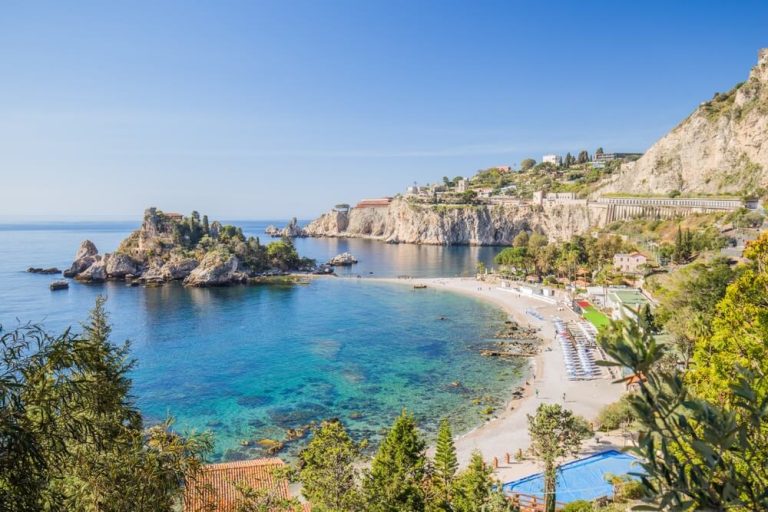
Accommodation and dining recommendations
If you decide to stay in Taormina overnight, there are plenty of hotels and B&Bs to choose from. However, the city is quite compact so it is easily explored in a day. Equally, this is one of Sicily’s most popular cities – especially in the summer – so many visitors prefer to stay in a Sicily villa to enjoy some peace and quiet away from the crowds.
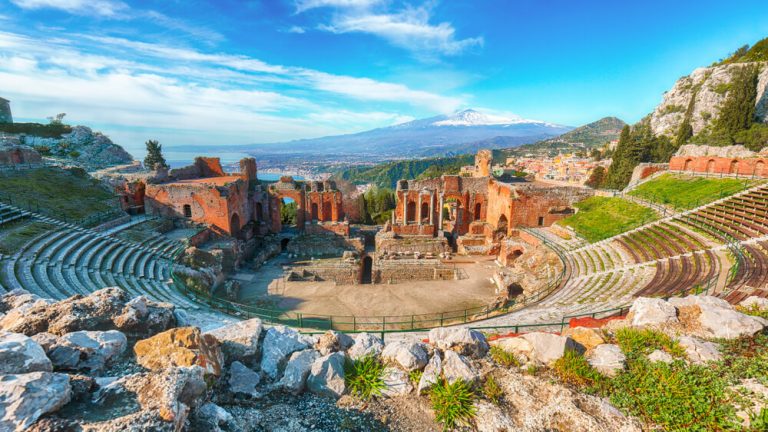
Like everywhere on the island, fish and seafood dominate menus in Taormina. Spaghetti ai ricci di mare is a local favourite. This is made with sea urchins and can be found on almost every menu in the city.
However, when we’re in Taormina our priority is always the sweet treats! Crema e Cioccolato on Via Bagnoli Croci is our favourite stop. Open from 7 in the morning, they serve delicious filled cornetti for breakfast and then a selection of cannoli which can rival any we’ve tried in Italy. However, the main event has to be the gelato. On a hot day there’s nothing like a pitstop to fuel-up on Italy’s most famous food and the gelato at Crema e Cioccolato is so good we think it’s even worth a second stop to try another flavour.
Things to do in Sicily
History and Culture
Sicily’s cultural richness begins with its geography. Sitting between Africa and Europe, it has been shaped by almost every great power of the ancient world.
The Greeks arrived first, leaving behind some of the finest classical ruins outside of mainland Greece. The Valley of the Temples in Agrigento and the theatre in Taormina still stand in near-perfect condition and are must-visit attractions in Sicily.
Next came the Romans, who built roads, aqueducts and villas adorned with magnificent mosaics. None finer than those at Villa Romana del Casale just outside of Piazza Armerina. Here, scenes of hunting, mythology and daily life are preserved in vibrant colour and intricate artwork.
After the fall of Rome, Sicily became a prize fought over by Byzantines, Arabs, Normans and the Spanish. In turn each left their mark, not just in politics, but in art, language and perhaps most importantly – food!
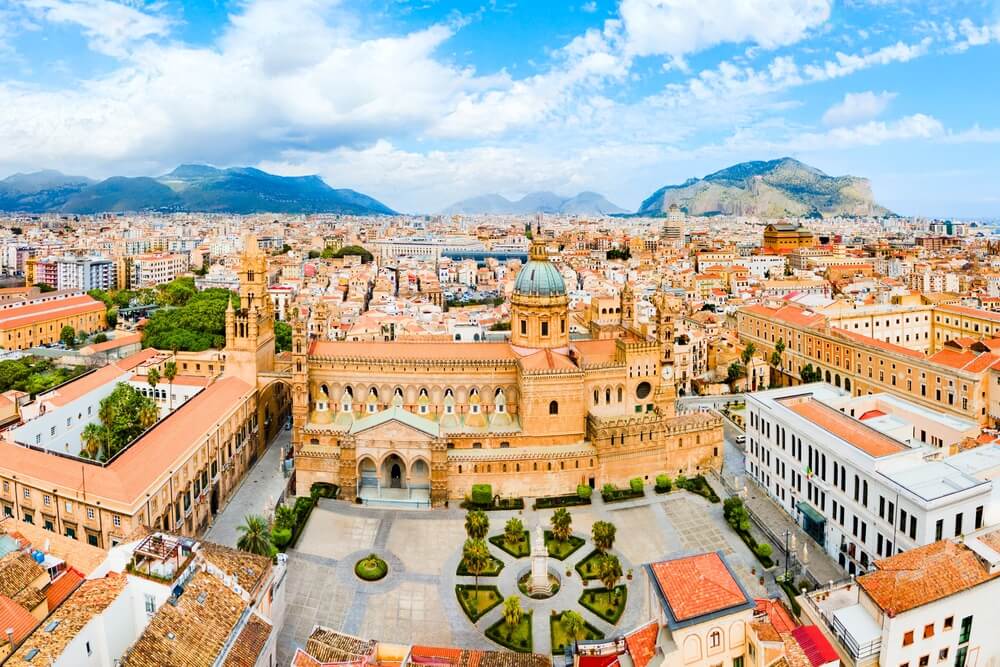
Sicilian culture is inseparable from its food. From the Arabs, Sicily inherited citrus fruits and rice, as well as spices such as saffron and cinnamon. These ingredients still season many Sicilian dishes today. The Spanish brought tomatoes and chocolate, while the Greeks and Romans left behind olive oil and wine traditions that have thrived across Sicilian hillsides for centuries.
At the heart of Sicilian culture are its festas (festivals). Across the island there are celebrations of saints, harvests and ancient rituals. But, more often than not Sicily’s festivals are sagre. These are food festivals. Amongst our favourites is the Couscous festival held each year in the seaside town of San Vito Lo Capo. Usually at the end of September, this 5 day culinary festival celebrates the Arab influences on Sicilian cuisine. We also love the island’s celebration of pistachios. This takes place in October in the town of Bronte near Mount Etna and celebrates the humble pistachio which grows on the fertile slopes of the volcano.
Vineyards and wineries
Sicily probably isn’t the first region you think of when it comes to wine in Italy. Tuscany is probably the first to mind, perhaps with Piedmont as a runner up. However, most people are surprised to learn that Sicily has 242,000 acres under vine, meaning it has more vineyards than any other region in the country.
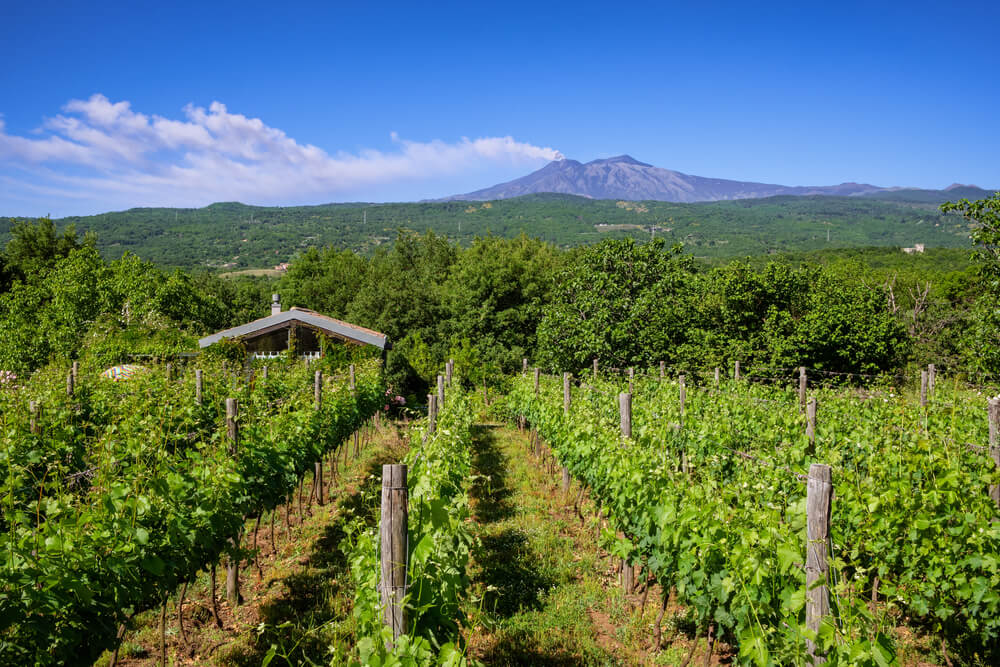
The island’s mediterranean climate is perfect for wine production and its varied landscapes and nutrient rich volcanic soil make almost perfect grape growing conditions. Sicily’s most well-known wine has to be Nero d’Avola. This is a sturdy red wine and the perfect partner for Sicily’s rich mediterranean cuisine. For white, Carricante is one of the best. Crisp and citrusy, it is perfect to sip under the warm Sicilian sun or paired with some of the island’s delicious seafood.
Joining a tour of a vineyard is a wonderful way to learn about Sicily’s history in winemaking but also a fantastic opportunity to join the expert wine-makers for a tasting. Book your tour and tasting here.
Exploring the Sicilian countryside
Away from the sun-soaked beaches and bustling piazzas, Sicily is home to some of Italy’s most unsung countryside. Inland you’ll find a tapestry of olive groves, vineyards and ancient forests. In the north, green mountains meet the Tyrrhenian Sea, while in the south, golden plains stretch toward sun-drenched coastlines.
In Sicily’s central regions it can feel like time has stood still. Hilltop villages, shepherds’ trails, and winding country roads expose an authentic Sicily that has changed little in centuries.
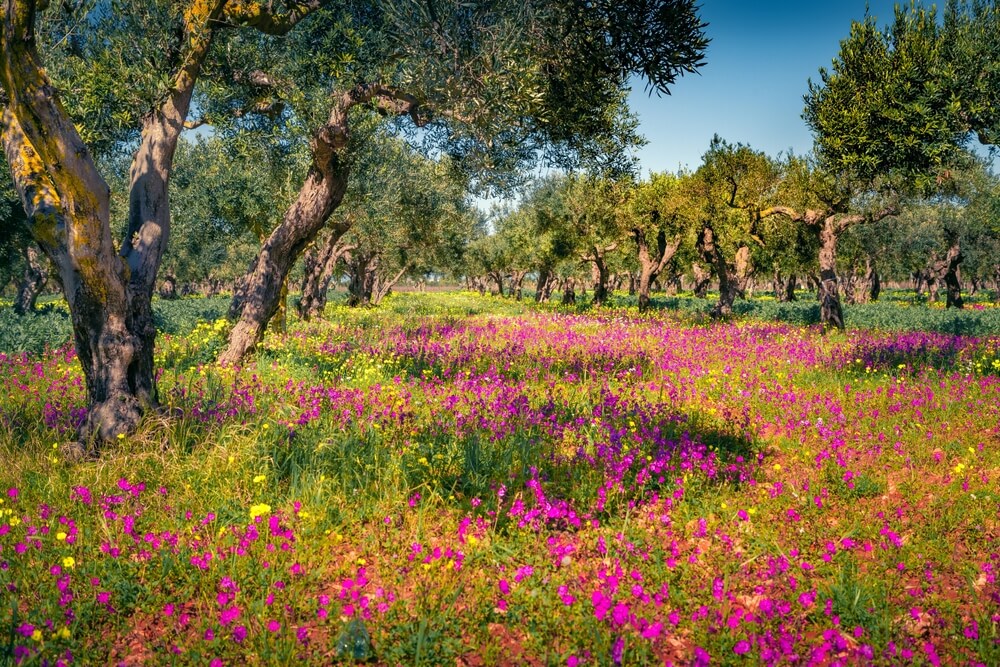
Sicily is home to four National Parks. The most well-known is the Parco dell’Etna. This houses the island’s most iconic landmark – Mount Etna. Lava fields and ash black slopes give way to fertile vineyards, chestnut forests as well as snow-covered peaks in the winter months. Visitors can hike along marked trails, take guided jeep tours, or ride the Funivia dell’Etna cable car to explore its extraordinary landscapes.
Further north, you find the Madonie Regional Park. This is one of Sicily’s greenest landscapes. Rising from the Tyrrhenian coast with peaks over 1,900 metres, it’s a haven for hikers and home to eagles, deer and a stunning show of wild flowers. Also in the north of the island, the Parco dei Nebrodi is wilder and can offer visitors a truly authentic Sicilian experience.
Whatever part of the Sicilian countryside you choose to explore, you will find an abundance of wildlife, flora and fauna. There are numerous paths and trails for walking and hiking. But, even if you’re simply driving through the Sicilian countryside en route from your Sicily villa to your sightseeing destination for the day, it’s a spectacular rural landscape to be admired and enjoyed.
Beaches
The beaches in Sicily are sublime. There are some incredible beaches in Italy and we think that some of the best beaches are on the island of Sicily. Italy’s largest island boasts nearly 1500 kilometres of coastline, just waiting to be discovered. And with temperatures warm enough to enjoy swimming in the sea as early as April and May and well into the autumn, there is plenty of time each year to enjoy them. There are far too many stunning beaches in Sicily to list them all in this guide. However, here’s a snapshot of our favourites.
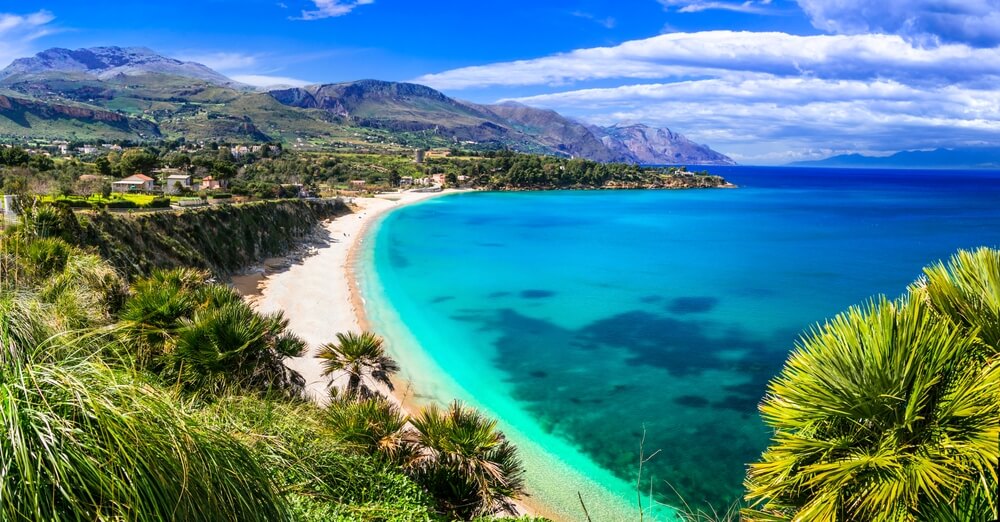
First up is the Spiaggia Naturista Torre Salsa. We really love this corner of Sicily and its beaches are a big part of the reason why. This stretch of coastline close to Agrigento is spectacular. Beaches stretch for miles and miles with soft golden sand meeting the Mediterranean for as far as the eye can see. This means the beaches are usually uncrowded and have a very natural feel to them.
The beach at the Torre Salsa nature reserve is typical of the area and is probably one of the best. Follow the road down to the designated parking area and then take the short walk to the beach itself. There is so much space here that everyone can feel that they have their own private beach. The chalky cliffs can be fun to explore and also make a homemade face mask if you fancy! The sea here is a little more exposed than on other sides of the island so it can be a little choppy at times. Just take care and follow any local safety guidance. That said, when we last visited, it was as still as a lake!
Some of Sicily’s best beaches aren’t actually on the Sicilian mainland but instead on Sicily’s islands and islets. This includes the Spiaggia dei Conigli (Rabbit Beach) on the south side of the island of Lampedusa. This is one of Sicily’s most beautiful beaches and at just 70 miles from Tunisia, it’s actually closer to Africa than mainland Sicily. Surrounded by a nature reserve and incredible azure seas which are more reminiscent of the Caribbean than the Mediterranean, this was voted the world’s best beach by TripAdvisor in 2013. And whilst you probably won’t find a rabbit in sight, it is one of the last remaining sites where you can find loggerhead sea turtles going to lay their eggs.
Last on our list is the Spiaggia di Cefalu. This is more of a ‘town beach’ than some of the others we’ve listed. However, what the beach in Cefalu lacks in unspoiled nature is easily made up for with charm and the spectacular views of the old town above. The beach is well-equipped with bars, restaurants, loungers and parasols. There are also some trees for natural shade and freshwater showers.
This is an ideal beach stop if you are exploring the historical centre of Cefalu and, in spite of its more urban location, it still boasts beautiful soft sand and clear blue water for a swim. If you’re travelling with older children, they may enjoy joining the locals in jumping off the pier for an adrenaline hit.
Best Places to Visit in Sicily
Sicily’s major towns and cities are all worth visiting while on the island. However some of the real treasures are found elsewhere and we think that they should also make it onto your Sicily bucket list.
Villa Romana del Casale
Dating to the 4th and 5th centuries AD, Villa Romana del Casale at Piazza Armerina holds the world’s largest collection of Roman mosaics. The most famous of these is the Coronation of the Winner. Known more affectionately as the Bikini Girls mosaic, it depicts 10 rather scantily clad ladies performing various athletic events including discus and weights. Allow at least 2-3 hours to explore the site properly and book a guide in advance to get the most out of your experience.
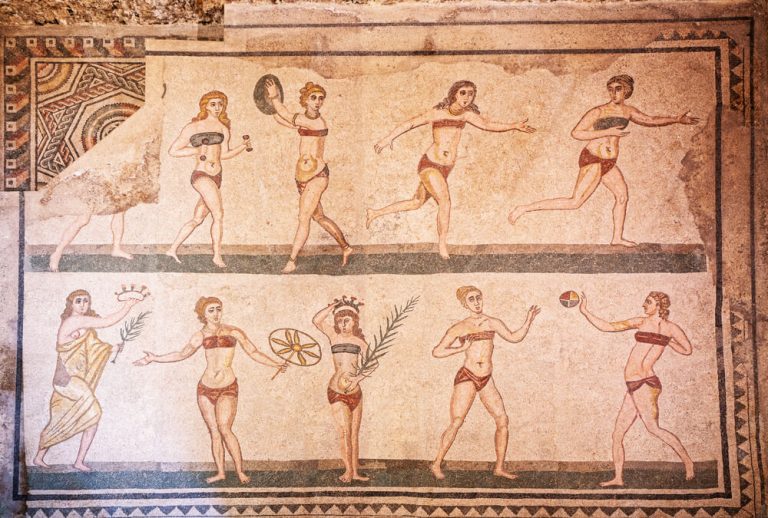
Mount Etna
One of Sicily’s most famous attractions is its active volcano. It is currently 3326 metres tall but its height does vary depending on summit eruptions. If you do want to head to the highest point, then you will need to go with a guide. The cheapest option is to join one of the organised tours of Mount Etna which tend to leave first thing in the morning. The experience involves hiking but does also make use of the cable car and jeep. Without the assistance of a guide, you will not be able to head above 2900 metres (Torre del Filosofo). If you’re not keen on a serious trek, then instead take the funivia that runs from Rifugio Sapienza up the mountain to a height of 2500 metres. A 4×4 minibus can then take you from here to the crater saving you the 3.5 – 4 hour round trip on foot.
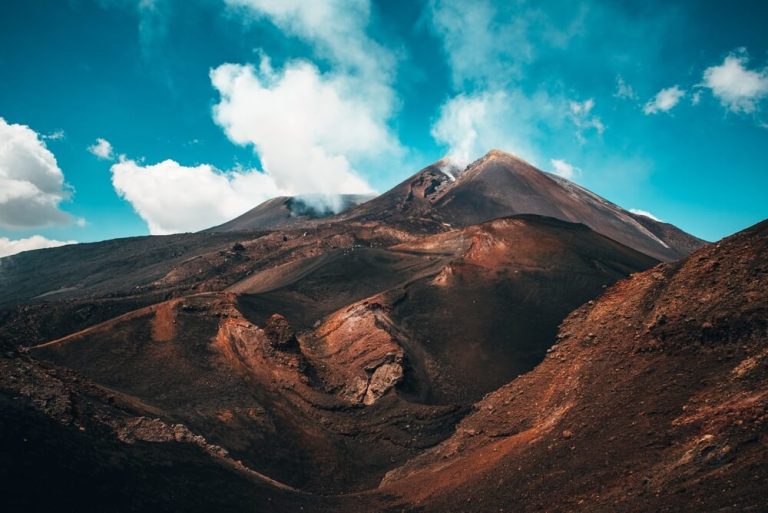
Temples of Selinunte
Set on the South Western coast of the island, the temples of Selinunte cover a vast area and are a superb example of the fusion of Phoenician and Greek culture. The city was destroyed in 409 BC by Carthage but excavations have unearthed eight temples, a fortification system and an acropolis. Not only is this one of the best historical sites in Italy, the archaeological park at Selinunte is also wonderfully beautiful. Perched above the azure Mediterranean sea, Doric temples and Roman ruins are dotted amongst the natural clifftop landscape. Book a tour with one of the local archaeologists which work here as guides.
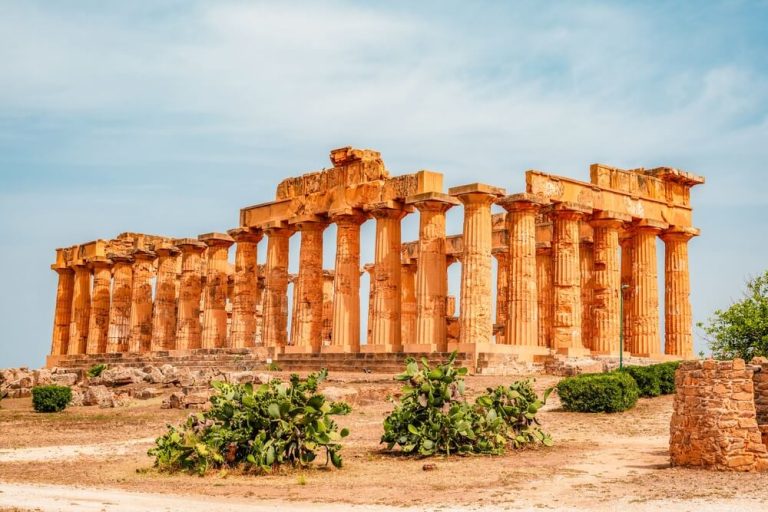
Aeolian Islands
A UNESCO World Heritage site, the Aeolian Islands are made up of seven separate islands: Vulcano, Lipari, Salina, Panarea, Stromboli, Filicudi and Alicudi. It’s a true paradise surrounded by stunning waters perfect for swimming, diving and other water sports. Lipari is the largest and most bustling of the islands. Head to Vulcano to enjoy the mud baths (fanghi) and hot springs as well as to witness the spectacle of the smoking Gran Cratere volcano which expels sulphurous fumes pretty much constantly. Visit Stromboli to lounge on the unusual black sandy beaches or to hike up the sides of the island’s active volcano. For a quieter, more luxurious feel, then Panaera is probably the best place for you to visit. Or, if you’re more into nature then head to Salina, Alicudi or Filicudi.
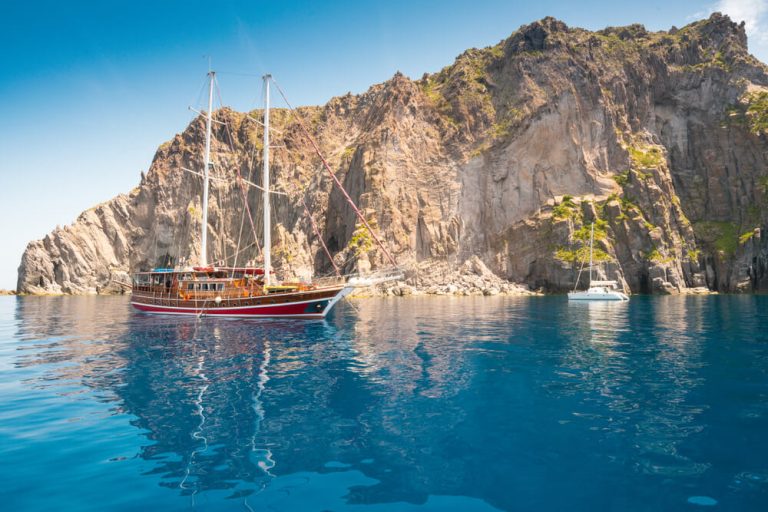
Valley of the Temples
The Valley of the Temples is a UNESCO World Heritage site near Agrigento. It features some of the best preserved Greek temples anywhere in the world. Dating back to the 5th century BC, the site includes the Temple of Concordia, the Temple of Zeus and a number of other sanctuaries dedicated to the gods.
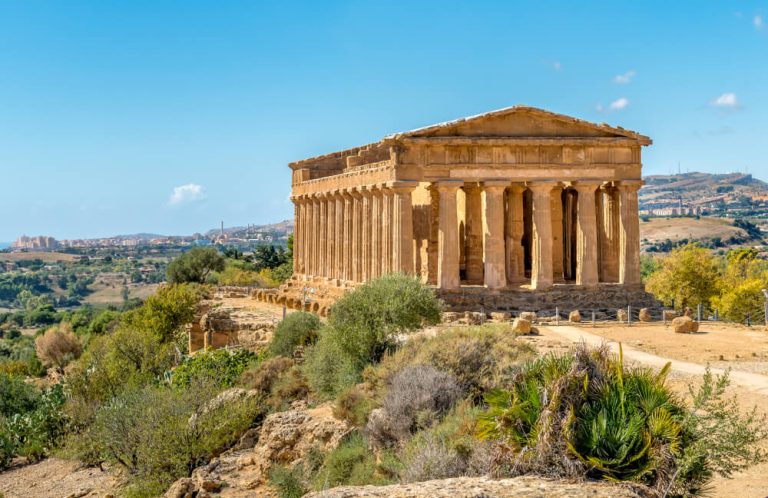
Parco Naturale Regionale delle Madonie
This is where you will find Sicily at its wildest and most remote. Explore its medieval hilltop villages, where life remains extremely traditional and authentic, and enjoy some of the most exceptional cuisine you’ll find anywhere in Italy! And marvel at the park’s incredibly rich biodiversity.
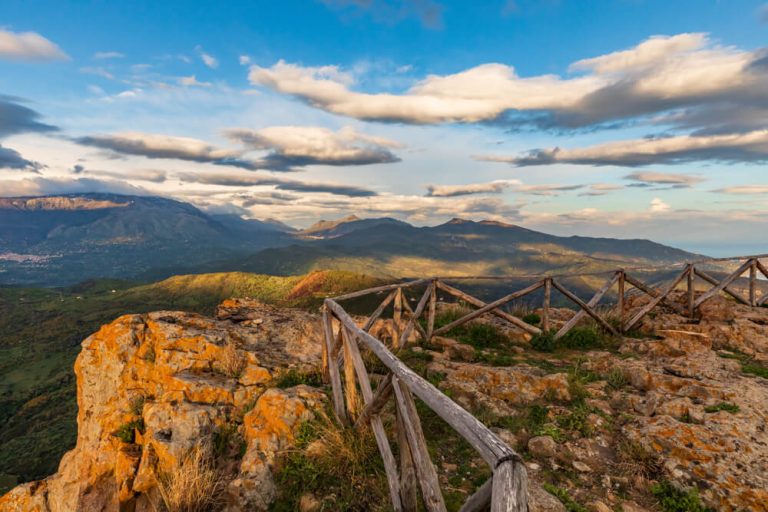
Riserva Naturale della Zingaro
In the west of the island, the Riserva Naturale della Zingaro is the oldest nature reserve. Enjoy the 7 km long coastal path from Scopello to San Vito lo Capo. Away from any traffic noise or signs of human habitation, just soak up the scent of the Mediterranean scrub and marvel at the views of the crystal clear waters below.
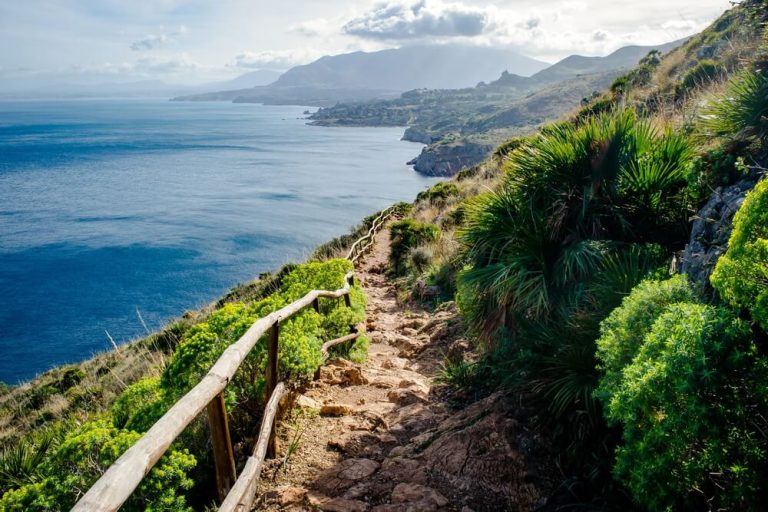
Egadi Islands
The Egadi Archipelago is made up of three islands – Favignana, Levanzo and Marettimo – along with the islets of Formica and Maraone. Favignana is the largest of the islands and, like Levanzo, boasts a rich history. Marettimo is the most remote of the islands and is ideal for hikers and walkers. In its entirety, the area makes up the largest protected marine area in Europe and is absolutely stunning. It’s also home to numerous species of fish, sea turtles and even seals. It’s perfect for divers and snorkelling enthusiasts who will discover shipwrecks and caves to explore under the water.
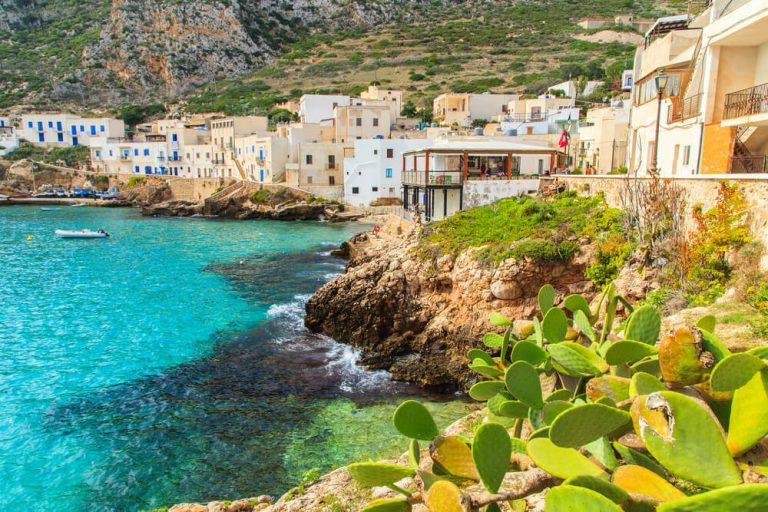
What to Eat and Drink in Sicily
As you can would expect from any Italian region, Sicily serves up the most delicious food. There are plenty of regional specialities we recommend you trying during your Sicily villa holiday. In fact, often referred to as a culinary crossroads – Sicily’s position on the edge of Europe and its rich and diverse history means it is one of the most interesting places to eat in Italy. There are plenty of must-taste regional specialities for you to discover on your Sicily villa holiday.
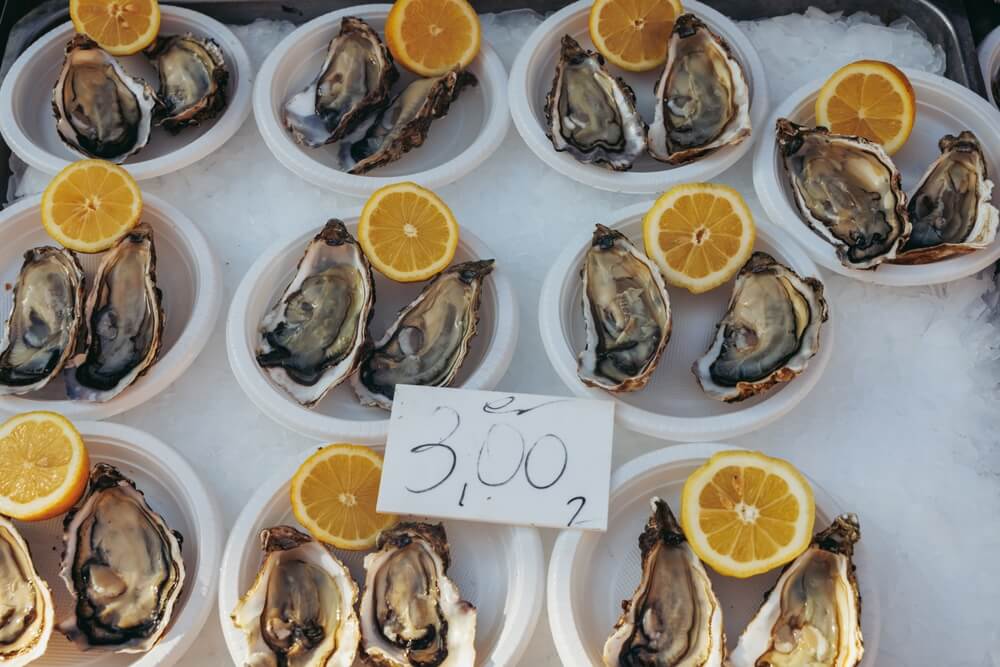
Couscous al Pesce
This is a classic Sicilian second course that is the coming together of traditional Italian and Arab cuisines. More often seen on menus in the Trapani region, the broth for this dish is seasoned with saffron and and cinnamon. Fluffy couscous is served with whatever fresh seafood has arrived that day and it more often features octopus and mussels or clams.
Pasta alla Norma
Catania’s signature dish, but widely available all over the island, this is a delicious pasta dish and also a vegetarian staple on Sicilian menus. Made with fried aubergine, tomatoes, basil and ricotta cheese, it is much more typical of traditional Italian flavours.
Caponata
This is one of Sicily’s most versatile dishes. Although it originates in the southern cities of Agrigento and Ragusa, caponata is found all over Sicily. Again, aubergines are the main ingredient, cooked in a tangy tomato sauce with celery, onions, capers and olives. Sometimes caponata is served as a side dish warm but you’ll also often see it served up cold like a salsa. Either way, it’s delicious!
Modica Chocolate
For those with a sweet tooth, this is a real authentic Sicilian treat. Modica, in the south of the island, is home to a very special chocolate making factory. Using a method which is very much like the Aztecs used, this specialist chocolate is made solely with cocoa and sugar. There is no fat or milk added to the recipe. The recipe requires that the chocolate is made at temperatures not higher than 50 degrees celsius and is known as a ‘cold press’. This means the sugar does not fully dissolve, giving the chocolate a slightly grainy texture.
Marsala Wine
In the far west of the island lies the city of Marsala which is most definitely most famous for its fortified dessert wine. Since the early 18th century, this local speciality has been produced in traditional cellars where this wine gains its uniquely sweet taste. With notes of dried apricots and singed brown sugar, this wine features in desserts such as tiramisu, biscotti and local chocolate cakes. However, it’s also a wonderful way to finish a meal as a digestivo or in a zabaglione – a kind of boozy custard that is digestivo and dessert all in one.
The Best Time to Visit Sicily
Sicily’s climate is mild well into the autumn months and also has wonderfully warm springs. The summer is hot. Often very hot. So, for this reason we recommend making your trip to Sicily in the shoulder season. This way you can use the whole day to explore Sicily’s finest historical sites.
A Sicily villa holiday in the Spring
Spring in Sicily is warm and the island comes to life with colour. Wildflowers bloom and citrus and almond trees blossom – this is one of our favourite seasons in Sicily. Like in most of Italy, Easter brings processions and celebrations along with some delicious feasts. April is also when Italy’s largest artichoke festival is held in Catania. In May, Noto hosts the Infiorata when the streets are literally covered with a blanket of petals, creating the most amazing flower displays.
Spring is the perfect time to discover Sicily’s hiking trails and adventure sports. At this time of year the air is clear and fresh before the heat of the summer sets in – it’s the perfect time to explore the slopes of Mount Etna or discover the majestic views on the coastal paths of the Zingaro Nature Reserve.
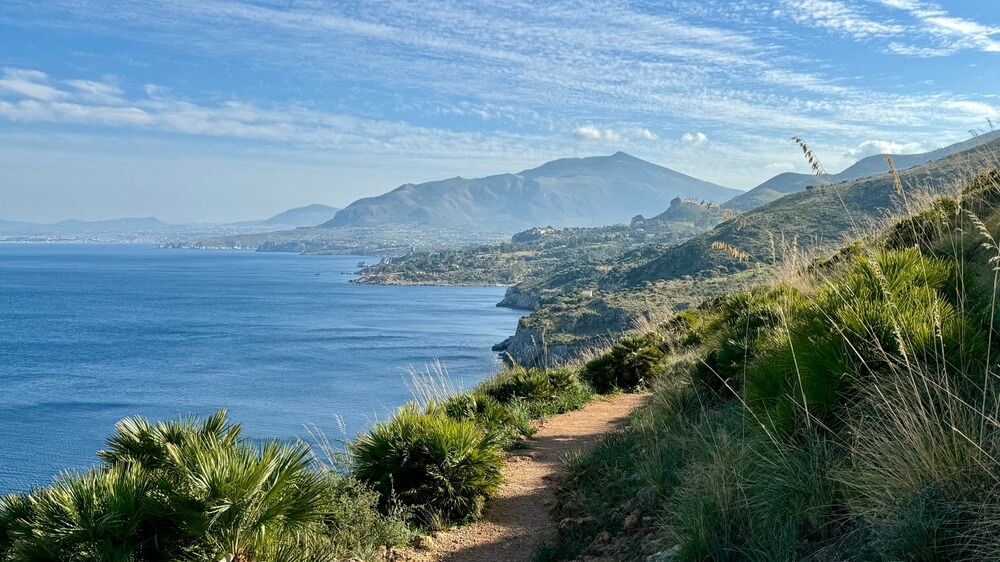
A Sicily villa holiday in the Summer
Summer in Sicily is hot. Daytime temperatures often climb well into the 30s. For this reason, many of Sicily’s towns can seem somewhat sleepy – especially during the afternoons. However, as evening draws in, Sicily comes alive. Sicilians eat late and often continue to socialise well into the night. Markets and shops also tend to be open late during the summer months.
These warmer days make the perfect time to enjoy Sicily’s stunning beaches. Discover our guide to the island’s finest beaches here. And while summer can be busy in Sicily, if you opt for the sanctuary of a Sicily villa in the countryside, you can enjoy the best of both worlds.
A Sicily villa holiday in the Autumn
Autumn is often described as Sicily’s sweet spot. The sea has been warmed by the summer sun, but the tourist crowds begin to thin. Temperatures in Sicily in the autumn vary quite significantly. September is definitely still beach weather and October can also bring temperatures well into the mid 20s. November does tend to mark a change in the season though with many tourist areas beginning to close. If you plan to visit Sicily in November, we recommend staying within reasonable reach of a bigger town with ‘year round’ amenities.
However, the highlight of a Sicily villa holiday in the Autumn is that it’s harvest season – making it the best time for food and wine lovers. A highlight is the island’s couscous festival. Held each year in the seaside town of San Vito Lo Capo at the end of September, this 5 day culinary festival celebrates the Arab influences on Sicilian cuisine. Another of our favourites is the pistachio festival which takes place in Bronte near Mount Etna. This Italian sagra (food festival) celebrates the humble pistachio which grows on the fertile slopes of the volcano.
Finally, like Spring, Autumn is the perfect time of year to get active in Sicily. The island’s hiking trails and cycle routes are much better enjoyed away from the intense heat of high summer.
A Sicily villa holiday in the Winter
While people don’t usually recommend visiting Sicily in the winter, we certainly wouldn’t rule it out. Sicily’s winter climate is still one of the mildest in Europe with temperatures regularly climbing to 20 degrees celsius. By choosing a Sicily villa holiday in the winter months, not only will you get a more authentic experience – away from most tourists – but you can also see great value for money on many luxury Sicily villas.
A highlight is Christmas in Sicily, where you will find bustling markets and nativity scenes to rival any on the mainland. But we also mustn’t forget Carnivale which takes place towards the end of February each year. The largest procession is in Acireale however the towns of Sciacca, Termini Imerese and Catania also have wonderful celebrations too.
How many days do you need in Sicily?
As Italy’s largest island, measuring 285 km from east to west and 185 km from north to south, you really do need at least a week in Sicily to see even just some of its highlights. Transport through the centre of the island can be time consuming as the major roads and rail links tend to link the larger coastal towns and cities. Ideally, it’s best to choose a Sicily villa near two towns you wish to visit and enjoy at least a 7 day stay there. Then, if you have longer, you could move to another villa in Sicily, on the other side of the island. That way, you can explore this area without spending hours in the car.
If you are short on time, then flying into either Palermo or Catania are the best options, as there is plenty to see and do in both of these areas.
At Bookings For You, we’d be delighted to help create a bespoke itinerary for your Sicily villa holiday. Our itineraries will be tailored to the location of your villa in Sicily and whether this is your first visit or you’re seasoned Sicily visitors, we guarantee to help you find your perfect place.
3 Days in Sicily
If you have just 3 days in Sicily, then we recommend choosing Palermo as your base. While you can stay in the centre of Palermo, to get the most out of your min-break you may want to hire a car to visit sites outside the city.
We recommend spending at least a day in Palermo itself, exploring the ancient architecture and to soak up city life in a working Sicilian city. Don’t miss the Capella Palentina (Palantine Chapel) or the city’s Duomo. And make sure you visit the Ballarò Market, where you can lunch on some delicious Sicilian street food.
Away from the city itself, combining trips to Monreale and Cefalù is a good, time-efficient way to discover these gorgeous but contrasting Sicilian towns. Try to end your afternoon on the beach in Cefalù – the perfect place for a sundowner.
With only three days to spend in Sicily, this may well be more than enough to fill your time. However, if you do want another suggestion, you could also spend a day discovering the archaeological parks at either Segesta or Selinunte. The former is about a 1 hour drive from Palermo. The site’s Doric temple and amphitheatre are beautifully preserved, offering panoramic countryside views. If you don’t mind a slightly longer drive, the park at Selinunte is the largest in Europe (and our favourite in Sicily). Not only are there some incredible temples to explore, the sea views and beach access make this a perfect way to end your Sicilian mini-break.
5 Days in Sicily
With just 5 days in Sicily, there will still have to be some compromises with your itinerary. However, in 5 days there’s plenty to make a trip to Sicily one to remember. The area around Agriento, in the south of the island, is a good base for a 5 day trip to Sicily. Although, that said, both Palermo and Catania could make equally good locations for a trip of this length.
Sicily is made for slow travel. By rushing from one big site to another, visitors can too often miss the authentic charm that makes Sicily so special. By sticking to exploring one corner of the island in a 5 day itinerary, we think you will have time to engage in Sicily’s wonderful culture and local traditions.
As an example, we recommend spring at least half a day discovering Agrigento’s old town, followed by an afternoon at the Valley of the Temples which is just a few miles outside of the city. If you can, aim to visit at sunset and have dinner in a restaurant with a view of the temples as they are tastefully illuminated against the darkening hillside. A trip to the archeological park of Selinunte is also a must if you’re staying in this corner of Sicily. Set aside a whole day for this and take a picnic to enjoy on the beach which is easily accessed from the park itself.
The nearby town of Sicacca is also a perfect addition to a 5 day Sicily itinerary. It is filled with colour from fascinating mosaic tiles and ceramics. Depending on how slow you like to travel, this can be combined with a trip to the Scala dei Turchi. Probably Sicily’s most instagrammable site, these naturally formed steps in the limestone cliffs lead to the glistening turquoise waters below. The beach here is also worth a visit – especially during the spring or autumn months when it’s crowd-free and pristine.
Your final day in this 5 day Sicily itinerary could be spent exploring the stunning Sicilian countryside or making the approximate 80 minute journey to Villa Romana del Casale to discover some of the finest Roman artwork and mosaics in the world.
A week in Sicily
Spending a week in Sicily makes it possible to split your time between two main bases. We recommend using our 5 day itinerary to explore the south west of the island before heading to Syracuse for the final two days. Here you can explore the magical island of Ortiga, along with the archaeological park which includes the magnificent amphitheatre and the almost mythical Ear of Dionysius. Alternatively, head to the beach for a couple of days of rest and relaxation. Stick to the south of the island for long sweeping natural beaches or head to the east coast for magical azure coves and rocky peninsulas.
10 Days in Sicily
Ten days in Sicily is enough to immerse yourself in the island’s wonderful culture. With more than a week to explore, there’s no need to rush. It also allows some time to simply relax at your Sicily villa. Some travellers may enjoy following our above 7 day itinerary but at a slower pace. However, if you’re happy to move around the island, then in 10 days it’s quite possible to enjoy three different bases. We’d recommend Syracuse, Agrigento and Cefalù or Palermo. Active travellers could also take the opportunity to explore Mount Etna or take a trip to the stunning Egadi Islands.
A Month in Sicily
Spending a month in Sicily can feel like a dream come true. Sicily’s diverse landscape, ancient cities and almost endless historical sites make it the perfect destination for an extended holiday. We recommend choosing the perfect Sicily villa (we can help you with this) and settling into living life like a local. While you can choose more than one base, we actually think that in a month, you can easily make trips from your villa to most places recommended in our itineraries.
With hybrid and remote working now our new normal, many visitors choose to extend their trip to Sicily and swap their home office for a stunning Sicily villa for a few weeks. This is the perfect solution for families looking to fill the summer break. All of our Sicily villas have pools to keep the kids busy as well as wifi and air conditioning to keep you cool and connected.
Sicily holidays for...
Sicily ticks so many boxes that it can have a broad appeal. Whether you’re 8 or 88, there is something in Sicily for everyone to enjoy. That said, we do think that some Sicilian destinations are better suited to some more than others…
For Couples
Sicily is the perfect place for a romantic getaway. Stunning landscapes and magical vistas make the most beautiful backdrop for a couples holiday. Enjoy days swimming in private coves or relaxing at a beach club. And then spend evenings sipping aperitivi in ancient piazzas filled with Sicilian charm. But there’s more to Sicily for couples than just these typical pastimes. Make memories together discovering archaeological treasures. Or adventurous couples can even scale Mount Etna. All of this, paired with delicious food and exceptional wine, make Sicily the perfect destination for couples.
For Families
A Sicily villa holiday can feel like a dream come true for families. The Sicily’s beaches are some of the finest in the world and younger families will love the gently shelving sandy shores of the south coast. Meanwhile, older children and teens will enjoy the adrenaline hit of coasteering and snorkelling around Sicily’s magnificent rocky coves. Either way, Sicily’s crystalline water is seriously inviting on a hot summer day.
Make memories together on a dolphin-spotting boat trip or watch newly hatched turtles make their first dash for the freedom of the ocean. Share time enjoying a family cooking class or simply switch off and relax at your Sicily villa. Family is at the heart of everything in Sicily, making it a dreamy destination for a family holiday.
Solo Travellers
With so much to see and do, Sicily is a great destination for solo travellers. Days can be filled discovering archaeological sites and historical wonders. And there are an abundance of group tours and experiences to join with fellow solo travellers. But equally, if you’re looking for a solo escape, Sicily offers peace and tranquility with its stunning countryside and magnificent coastline.
Solo travellers in Sicily have the benefit of complete flexibility. So why not enjoy a few days in Agrigento or Syracuse soaking up the city vibe and then head into the countryside for a more authentic Sicilian experience. Of course, a huge pro of solo travelling in Sicily is that you can avoid the busy school holiday months of July and August. Visit in June or September and you can feel like you have struck gold.
For Groups
Opting for a beautiful villa in Sicily is the perfect solution for gatherings of friends or extended families. Enjoy the privacy and space that comes with a self-catering villa, whilst also embracing the wealth of cultural experiences Sicily has to offer. Large Sicily villas with pools and gardens are the perfect places to make memories together with friends and families. And, why not treat yourselves and also hire a private chef so everyone can relax.




